|
NATIONAL PARK SERVICE
Fauna of the National Parks of the United States No. 1 A Preliminary Survey of Fauna Relations in National Parks |

|
ANALYSIS OF THE MAJOR TYPES OF WILD-LIFE PROBLEMS THEIR CAUSES AND TREATMENT
THE BASIC CAUSES OF PRESENT FAUNAL MALADJUSTMENTS
When a roster of typical wild-life problems from the whole national park system was assembled, a very wide range of maladjustments was revealed. A systematic analysis was made to trace each problem back to the basic disturbance which brought it about. For if any common denominators could be found, that knowledge would be a key to devising a betterment plan. Early in the work it became apparent that the fundamental causes were relatively few. If a number of problems could be traced to a common origin, more rapid and orderly progress in wild-life administration would be possible than if each problem were dealt with as an isolated instance.
From this analytical study the conclusion was reached that present complications in the status and environmental relations of park animals have come from these three general sources:
1. Adverse early influences – The present unsatisfactory status of an animal may be the result of a destructive force which itself is no longer active. These are problems caused by early influences. It is convenient to think of them as the problems of historical origin. Problems of this class fall into two groups, according to whether the influence was one which destroyed these fauna directly or one which operated indirectly by altering some part of the environment upon which the fauna depends.
2. Failure of parks as independent biological units. – A park is an artificial unit, not an independent biological unit with natural boundaries (unless it happens to be an island). The boundaries, as drawn, frequently fail to include terrain which is vital to the park animals during some part of their annual cycles. The smaller the total area of a park the more its animal life may be endangered by external influences. Problems caused by the failure of parks as biological entities have to do with their geographical aspects, such as size and boundary location. It is easy to think of them as problems of geographical origin. They logically fall into two groups, according to whether they have come from failure to include all habitats required by park animals or from external influences which do not find the boundaries a natural barrier.
3. Conflict between man and animal in the park. – Troublesome situations inevitably arise when men and certain animals with conflicting interests try to occupy the same places at the same time. These complications come in spite of the human ideal that the wild life of the parks shall remain in a primitive state unmodified by civilization. Disturbances of this origin constitute the third class, the problems caused by conflict between man and animal through joint occupancy of the park areas. For brevity's sake they may be designated as problems of competitive origin. And once more it is profitable to make two divisions, this time according to whether problems are due to injury of man by the animals or due to man's occupation of the area affecting the fauna adversely.
 FIGURE 9. – Occasionally the interests of men and animals conflict. A bear profited in this foray to the extent of one roast of lamb. Photograph taken September 11, 1929, at Canyon Lodge, Yellowstone. Wild Life Survey No. 452 |
These three basic causes are responsible for the multitude of problems which must be solved with at least fair success if the faunal resource of the national parks is to be conserved.
The administrative measures invoked in every instance must he analysis gaged by accurate analysis of the causative factors which bred the problem. This is important. It is the key to proper practice in the program of wild-life administration upon which the parks have unavoidably embarked. In the end the Service either will be praised for intelligently conserving the last fragments of primitive America or condemned for failure to hold to the real purpose by shooting clear over the mark and practicing game farming instead.
The rigors of civilization have injured the fauna of the country as a whole. In a national park the damage can not be undone by policing a boundary line. This is protection and it is necessary, but it does not correct conditions already operative within the park. These must be sought out where they are doing damage and dealt with there. This is management, and the danger that it may be overdone is not sufficient reason for doing nothing.
Recognition that there are wild-life problems is admission that unnatural, man-made conditions exist. Therefore, there can be no logical objection to further interference by man to correct those conditions and restore the natural state. But due care must be taken that management does not create an even more artificial condition in place of the one it would correct.
If each problem is carefully analyzed as to its cause, and the type of management appropriate to problems caused in that way is then applied, management will not destroy its own purpose. Admittedly, the tool is a dangerously sharp one to use in a national park. That is why it must be handled within skill in biological engineering, a science which itself is in its infancy.
It is important in every case that the hand of interference should not be exercised beyond the point that is necessary to do the work. In some instances if the situation responsible for the maladjustment of a species can be corrected, that bird ear mammal will come back to its former status. Failing this, additional measures may be temporarily necessary to help it recuperate its strength. But where the basic disturbance can not be eliminated, management to counteract the evil effects may have to be instituted to continue so long as the harmful influence continues.
All of the problems which the survey has encountered to date are believed to be of historical, geographical, or competitive origin. The following outline lists major types of problems in each of these causative groups.
TYPE PROBLEMS LISTED BY CAUSE
| CAUSE | PROBLEM | |
|---|---|---|
| I. Earlier influences (historical) | ||
| a. Operating directly ------ |
1. To re-establish an extirpated species. 2. Treatment of a species reduced to danger point. 3. To restore a depleted habitat. | |
| b. Operating indirectly ----- | 4. Treatment of a species become unnaturally abundant. | |
| II. Failure of parks as independent biotic units (geographical) | ||
| a. Lack of complete animal habitat in park -- | 5. Lack of winter range. | |
| b. Encroachment of external influence ------ |
6. Reduction of park animals black-listed outside. 7. Invasion of exotics into the park. 8. Dilution of native stocks by hybridization. 9. Exposure of native animals to diseases and influences of alien faunas. | |
| III. Conflict between man and animal within the parks (competitive) | ||
| a. Animals interfering with man ------ |
10. Unusual damage to landscaping. 11. Conflicts with fish culture. 12. Animal injury to life or property. | |
| b. Human developments harmful to wild life -- |
13. Disturbance in development centers. 14. Effects of pasturing saddle horses. 15. Disturbances on breeding grounds. 16. Altered status because of manner of presentation. |
The scope of this report prevents discussing at length every problem encountered. Consequently the plan has been adopted of discussing the essential elements of each type of problem listed above and illustrating each with one or more examples treated in detail. These examples will serve as type problems to which others resulting from similar causes can be referred for comparison and study. Then in later sections dealing with the vertebrate life of each park as a unit, only those problems on which the survey has accumulated special data have been accorded more than outline treatment.
Where it seemed that more than one of the major causes entered into a certain problem, close inspection revealed that one of them was dominant in producing the present situation. These have been handled by allocation under their dominant cause.
The type problems given in the next three sections are arranged in accordance with the foregoing outline. They have been numbered to conform with the Arabic numerals in the outline merely to facilitate reference and to further emphasize the relation of problem to cause.
PROBLEMS OF HISTORICAL ORIGIN
THE RESULTS OF EARLIER INFLUENCES
All depending upon the history of development of the region, the fauna of a park at the time of establishment was either much the same as it had been originally or it was greatly altered. The scheme of wild-life administration should meet the latter condition by corrective measures. Maladjustments caused by factors which have been eliminated from the park area will not necessarily correct themselves because these original causes are no longer operative. Where the status of species which have been adversely affected continues without showing improvement for a number of years after full protection has been established, management should be applied.
CONDITIONS CAUSED BY DIRECT EFFECT OF EARLY INFLUENCES
The status of wild life was impaired directly and immediately where animal populations were decimated by trapping, shooting, or poisoning. Some species were actually exterminated from the areas before they became parks. Others had been reduced to small numbers and recuperation has not resulted from park protection. Drains on a species from natural causes which are not ordinarily fatal because of an ample breeding stock may be overwhelming when it has been reduced to a few mated pairs per unit area.
TO REESTABLISH AN EXTIRPATED SPECIES (1)
Restoration of an animal which has been exterminated is desirable not only because it will bring back that species itself, but because it will fill once more the niche that was deserted, and so help to restore the life of the park to its primitive dynamic balance. If the extirpated species is still present in the region, reoccupation of the park by natural spread should be encouraged. This is the best answer from the standpoint of expense and likelihood of lasting success. If on the other hand, there are natural or artificial barriers in between the park and the present occupied area, restocking must be the answer. If the animal is decreasing everywhere, this step must be taken promptly.
Thus the procedure adopted for meeting the individual problem will be largely determined by the status of the animal outside the park, as is illustrated in the following examples:
Grizzly bears in Sequoia. – The grizzlies of California are extinct. The suggestion has been made a number of times that replacement be made with a Rocky Mountain grizzly. This would be such an obvious mistake that it has never been seriously considered, yet in other instances of this same kind the incongruity might be just as great though not so immediately apparent. If an animal is extinct, the situation is beyond remedy. Attempt to replace the original with a related form would merely serve to create a new problem, the introduction of an exotic with different characteristics and, more especially, different ecological requirements than its extinct relative.
Mountain sheep in Yosemite. – The Sierra Nevada mountain sheep (Ovis canadensis sierrae) disappeared from Yosemite before the close of last century. Old horns and skulls are still found about high cliffs. There is a living remnant of this bighorn in the southern Sierra near Mount Whitney, where it is reported to be slowly increasing under protection. Two other related subspecies are the Lava Beds bighorn to the north, which is probably extinct, and the Nelson bighorn, which is still extant on some nearby desert mountains to the south.
Many have already expressed a wish to see Yosemite National Park restocked with mountain sheep, there being even some indication that private support might be forthcoming for such a project. The waiting policy adopted by the Service is the only justifiable course for the present. So long as the Sierra Nevada form still exists, it is the only source which can even be considered for reintroduction purposes. A gradual return of the southern remnant is the ideal solution, and there is a fighting chance that this will take place if it continues to increase and reoccupies its range northward along the crest of the mountains. Continued heavy grazing by domestic sheep between Yosemite and Mount Whitney will be a serious obstacle here.
Even though natural reestablishment should be considered too remote a possibility, waiting would still be a necessity for practical reasons. The southern band is still small and the sheep are rarely seen. They should not be disturbed; but if they were, success in capturing the necessary number and transporting them to Yosemite would be very unlikely. It would not pay to release such costly animals as these would be near the crest of the mountains. The park unfortunately does not include the east slope, which is the habitat preferred by the sheep. They are particularly dependent on this side during the period of heavy snow, and would be without the benefit of park protection at such times.
To sum up, the conclusions in this problem are: Return of the mountain sheep to Yosemite should be planned for, because the native form is still in existence; the procedure indicated by the elements of the case is to do nothing now except to watch the Mount Whitney sheep until either they work back naturally, or, failing that, become sufficiently abundant for a restocking experiment to have a chance of Success.
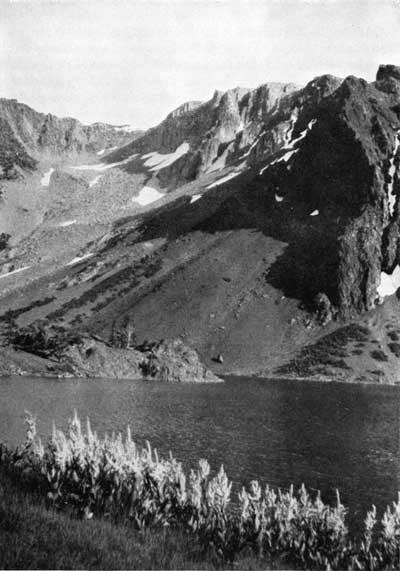 FIGURE 10. – Mount Dana. The eastern slope of the range, now outside Yosemite boundaries, would be needed by mountain sheep in winter. Photograph taken July 30, 1929, at Tioga Pass, California. Wild Life Survey No. 296 |
Wild turkey in Mesa Verde. – In the foregoing example the return of the mountain sheep to Yosemite is shown to be desirable, providing it can be accomplished under the proper conditions. Let us examine a second case – one in which the basic action itself is in question.
The problem is: Should the Merriam Turkey (Meleagris gallopavo merriami) of the Southwest be placed in Mesa Verde National Park ?
The Cliff Dwellers kept turkeys confined in the caves behind their dwellings. Turkey-bone implements and pieces of turkey-feather robes have been recovered, as well as many other evidences that the wild turkey was present and was an essential part of the Cliff Dwellers' economic, and possibly religious, life. There are no definite records or indications of the presence of turkeys on the mesa to-day. It would be of unusual interest and of educational value if these wonderful birds were occasionally seen, or, at least were known to be present, hidden in the forest and canyons of the mesa. In the thoughts of the visitor, these birds would be as a far cry back to that earlier life and culture, a symbol to link him more closely to that civilization as a reality. Their presence would lend a further charm and color to the wild life of the mesa to-day. But there are other considerations.
Is this the native habitat of the wild turkey ? "It is significant that by choice we find them in or near the yellow-pine type and always where living water – springs or streams – is available. Nowhere, in the memory of the oldest citizens of the State, have turkeys been resident where pine was not in evidence. If for no other reason, the adult birds seem to insistently choose pine trees in which to roost."7 There is almost no yellow pine on the mesa, and water is very scarce.
Did turkeys ever exist here naturally, or were they brought here in a semidomesticated state by the Cliff Dwellers ? If they were brought here, from where did they come ? Probably the nearest representatives of the Merriam turkey are those found in the Chusca Mountains between Arizona and New Mexico, north of Gallup. However, they are in an extensive yellow-pine country, which is their native habitat. Since they are found so close to Mesa Verde, it would not be surprising to find that they were at one time native to the mesa, except for the scarcity of yellow pine and water.
The following note on the wild life of the Chusca Mountains region is given by Vernon Bailey: "The Navajo Indians in their religious reverence for feathered spirits have made their great reservation to some extent a bird preserve. Ducks are unmolested in the lakes and doubtless breed there in considerable numbers. Wild turkeys have held their own unusually well, but have suffered somewhat from hunting by outsiders and Christianized Indians."8
Were turkeys left here after the Cliff Dwellers departed ? If so, what has become of them ?
If turkeys were not native to the mesa, would it not be confusing the whole significance of their part in Mesa Verde culture to place them there, and give the impression that they were native to the mesa? The significance of a visit to Mesa Verde is that it acquaints one with an earlier civilization through the actual remnants of that civilization, and it shows how that civilization was modified by, and adapted to, its particular environment. If we introduce an alien factor into the immediate setting, we are destroying the significance of the whole complex relationship between culture and environment.
These thoughts are not given to oppose the reintroduction of wild turkeys into this park. They are given simply as a preliminary analysis of the complexity of such a problem, and as an indication of some of the interactive factors which have to be considered before there can be a proper decision.
Once the desirability of reintroducing an exterminated species has been demonstrated, there are the practical problems to be worked out in the field, such as:
(a) Where the nearest representative of the species may be found.
(b) Practical means of securing pairs for reintroduction.
(c) The matter of cost.
(d) Practical measures, if necessary, for temporarily protecting the new stock until it establishes itself.
7 Wild Life of New Mexico, by Ligon, J. Stokley. State Game Commission, Department of Game and Fish, Santa Fe, N. Mex., 1927, p. 113.
8 Life Zones and Crop Zones of New Mexico, by Bailey, Vernon. North American Fauna, No. 35, 1913, p. 61.
TREATMENT OF A SPECIES REDUCED TO DANGER POINT (2)
In discussing the problem of a species whose numbers have been reduced to the danger line by the pioneer depredations of man, it is admitted that possibly nothing can be done to bring that animal back to its former status. Yet even this knowledge can not be had without first making a thorough investigation of the question, including, perhaps, experiment with some betterment measures. On the other hand, many species might be brought back if their plights and all the governing factors were sufficiently understood. A temporary program of special protection to bring about recuperation might include securing greater immunity for the young against enemies on the breeding grounds, or augmenting the food supply at a critical period, or some other measure, depending entirely, of course, on the individual circumstances of the case. In any event, every precaution should be taken against endangering the status of any other species while trying to help one; and, always, the special protection must be discontinued just as soon as the species is out of danger.
Trumpeter swan in Yellowstone. – This is perhaps the best example for this type of problem, not only because the number of trumpeter swans in the Yellowstone region was reduced to a few birds but because these represent the entire known breeding stock in the United States.
Though the trumpeter swan (Cygnus buccinator) and the whistling swan (Cygnus columbianus) are so much alike in appearance as to be almost indistinguishable in the field, the first has all but succumbed, while the latter continues to flourish. Comparison of the two forms is valuable in analyzing the present problem.
The whistling swan bred mainly north of the Arctic Circle, its nesting grounds unaffected by civilization. The trumpeter swan bred in Canada and the great interior valley of the United States, where it was subject to every adverse influence, even to the draining of many of the small breeding lakes.
As winter visitants in the south the whistlers were very shy, so that few were taken by gunners. They came down along the coasts and kept to open waters. The trumpeters, on the other hand, were much less wary, frequenting smaller bodies of water and coming in close to the hunters' blinds.
A whistler might weigh 18 pounds; a large trumpeter, 33. Consequently, the trumpeters made more desirable skins and must have been at a premium in the great swan trade of the Hudson Bay Fur Co., which destroyed the bulk of these birds, even to the northern part of their range, long before permanent settlement came along to do the rest.
As a result of all these influences the trumpeter swan nearly passed from the picture. Its present status is as follows:
In Canada : For conservation reasons, the Canadian Government keeps its data on this species a secret. It is known that a few winter in southern British Columbia, but their breeding grounds have not been discovered. They are believed to be in the northern part of the Province, where, if any colony is found out by Indian or prospector, it is sure to be destroyed.
in the United States : Though the trumpeter may possibly occur south of the international boundary in migration, it is gone as a breeding bird except in the immediate Yellowstone region. All recent nesting records are within the park except for two stations – Jackson Lake, Wyo., and Red Rock Lake, Mont.
The latest breeding census made by the survey party in 1931 showed 5 breeding pairs and 10 birds not breeding. The 5 nests are known to have hatched 18 cygnets, of which 5 were certain losses in the summer, leaving a potential crop of 13. Probably there were further reductions before flying time in late fall, and still others before the winter was over. What this means for perpetuation becomes more significant when one takes into account that breeding age is not attained until the fourth or fifth year.
In captivity : Mr. F. E. Blaauw, of Holland, secured five trumpeters over 30 years ago. Though he has been successful with them, his present stock consists of only 10, of which 5 are immature. In the past few years 12 of Blaauw's birds went to the Kellogg Bird Sanctuary at Battle Creek, Mich. It has not been ascertained that these have bred there.
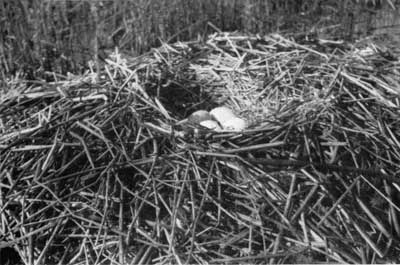 FIGURE 11. – Only the watchfulness of the parents deprived ravens of a feast on the four large eggs of this trumpeter swan nest. Photograph taken May 30, 1931, at Trumpeter Lake, Yellowstone, by G. M. Wright. Wild Life Survey No. 2353 |
So much for the general picture. What can be done to perpetuate and increase the trumpeter swan in Yellowstone Park ? Report was received in 1929 that a pair on a small lake in the Lamar Valley had failed to raise any young in the four or five summers they had been observed. In the spring of 1930 the survey party found two nests – the one mentioned above and a second on Mirror Plateau. Each clutch was composed of six eggs. Yet there was but one living cygnet by late autumn.
Suspicion fell upon a number of possible enemies, but only one was convicted. A raven broke an egg in the nest on Mirror Plateau and tried to fly off with the embryo. There were frequent raids by the ravens at the other nest, but they were successfully resisted.
Potential enemies of the cygnets were the coyote, otter, horned owl, eagle, and possibly even the badger. Coyote tracks were abundant around the margins of the lakes, and badgers lived all around. The entire swan families frequently took to the land to feed or to cross to near-by ponds, and they would be easy prey at such times. When the cygnets were small, an otter visited the Lamar Lake. Coots within 6 or 8 feet of the otter showed curiosity, but no fear, and were ignored in return. Neither was the swan family hurt. In the fall, when the cygnets were disappearing one by one, an otter family came to stay in the lake for a time. Coot and ruddy duck remains were found in the feces, but no sign of a cygnet. The otters were not proved guilty.
One night in the following summer a member of the party slept at the very edge of the lake so that he might hear any unusual sound. In the morning one cygnet was missing. Horned owls were in the air that night, but this was not hanging evidence.
This season was a dry one. Several lakes reputed to harbor swans were found to be so low that even beaver houses were left dry. This suggests that in certain years swans attempting to nest on shallow waters may have their lakes vanish, or at least shrink until the nests are accessible to land enemies.
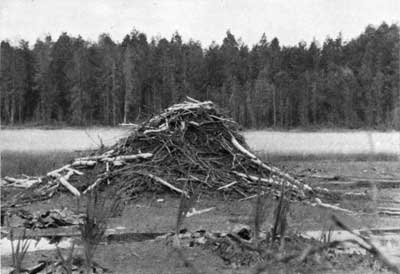 FIGURE 12. – Shallow lake in the Bechler district in a dry season. Trumpeter swan nests may suffer the same fate as this beaver house. Photograph taken July 24, 1931, in Yellowstone, by G. M. Wright. Wild Life Survey No. 2292 |
Winter status of the trumpeters was an open question because their movements after they were frozen out of the home lakes were not known. But during a cold spell early in 1932, 28 swans appeared on thermally warmed waters in the park. At the end of February the count totaled 41. This was good news, for, if the Yellowstone birds remain in or near the park in winter as well as summer, the hope of saving them is greatly increased.
The present indication is that the swans are at least hanging on. This permits of a little more time for intensive research to discover the critical factors during the periods of incubation, of raising the cygnets, and of absence from the breeding ponds in winter.
Many protective measures have been suggested, but it seems inadvisable to try much without better knowledge of the basic facts unless a tendency to further decrease becomes apparent. That would be an emergency justifying drastic action, such as removing all suspects from around the nesting lakes or raising a portion of the cygnets in semicaptivity where conditions could be definitely controlled. Measures in addition to the above which have been proposed are : Fencing coyote-proof lanes for swan travel between lakes, ranger detail to keep ravens cleared out during the incubation period, prohibition of entry to the breeding lakes by park visitors, enlistment of public support to wipe out the vandalism which is known to affect the swans when they are outside the park, and other suggestions.
The partial conclusions from investigations made to date are that whereas the trumpeter swan was decimated as the result of civilization's influence, and whereas the species may not be able to come back under ordinary park protection, it is desirable in consequence that there should be a program of careful study with a view to resorting to intensive management if further developments prove the necessity. This does not fail to recognize that low survival rate of cygnets may be normal for this species, inasmuch as the swan is long-lived and has relatively few natural enemies when full grown. But when the trumpeter is nearly extinct, it is important for as many cygnets as possible to survive, at least until such time as the breeding stock is restored to numerical safety. It is a case where special protection is amply justified as a temporary measure.
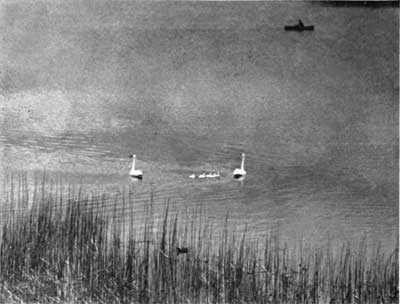 FIGURE 13. – Adult trumpeters and six cygnets (one hidden in tules). The grown birds are powerful and capable of protecting their young in the water, but all are at a disadvantage on land. (Note rubber boat used by Survey in distance.). Photograph taken June 20, 1930, at Lamar River, Yellowstone. Wild Life Survey No. 880 |
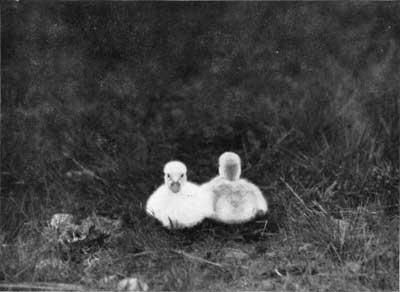 FIGURE 14. – Two trumpeter swan cygnets from the same brood. Do young of the gray phase have a better chance of escaping enemies than those of the white phase ? Photograph taken June 12, 1931, at Trumpeter Lake, Yellowstone by G. M. Wright. Wild Life Survey No. 2268 |
CONDITIONS CAUSED BY EARLY INFLUENCES OPERATING INDIRECTLY
Major influences responsible for injuring wild life indirectly were stock raising, agriculture, and lumbering. These human activities which affected the fauna adversely through altering essential elements in its environment have left behind them problems of very complicated nature. The ramifications of the upsets they caused are great, and, consequently, difficult to disentangle. One of the worst influences, that of grazing, has not yet been completely eliminated. That is an objective which must be consummated at the earliest possible date. From the wild-life standpoint, an area is not a national park in fact until all domestic stock is permanently removed. The policy of not renewing permits when they expire seems to be the fairest method of meeting this situation.
But with the above exception, the original influences have been removed from the parks proper. The first step, then, in solving the problems which they have left behind them is to restore the altered environment to its original state, which was known to have been favorable to the species in question. Because this restoration may take a long time to accomplish, the species suffering may have to be sustained by a temporary program of assistance. If it is a case of a depleted range, the range itself may have to be temporarily protected against the animal until its grazing capacity is restored.
TO RESTORE A DEPLETED HABITAT (3)
It is hardly necessary to point out the close relationship between animal life and food supply. This refers not only to the grazing and browsing areas of the ungulates, but includes the food supply of every type of animal life; i. e., if rodents and other forms of marten food have been destroyed, the marten's range is just as truly depleted as that of the elk when palatable herbage and browse are gone. And again, if wild life is managed along the all-too-thrifty and enterprising lines of a game farm, the range of the scavengers is apt to be empty. It is necessary that the trees be left to accumulate dead limbs and rot in the trunks; that the forest floor become littered; and that the wild life be left to prey upon itself in order that the range may not be destroyed for any species and that vigorous, healthy animals may be left in every niche.
Turning to the most obvious and important type of depleted food supply due to early conditions, we note especially that almost every range suitable for big game was overgrazed by sheep, cattle, and horses before 1900. In order to get some idea of the condition of the grassland ranges in their primitive condition, even when the great herds of buffalo and antelope roamed them, the following account from Coronado's explorations in 1540 through the territory now embracing the Southwest and prairie States is enlightening : "Who could believe. that 1,000 horses and 500 of our cows and more than 5,000 rams and ewes and more than 1,500 friendly Indians and servants in traveling over these plains would leave no more trace where they had passed than if nothing had been there – nothing – so that it was necessary to make piles of bones and cow dung now and then so that the rear guard could follow the army."9 There was rank growth of the tall grasses then, whereas now the tall grasses are mostly gone, and even the short grasses are gone from many parts of the western range. In their places have come the unpalatable species that inevitably follow overgrazing. So that even where a range seems to be well covered, it may be with the unpalatable and undesirable types which leave little food for the game. This is the condition which exists in nearly all our parks to some extent, and especially in the Southwest parks and monuments.
Deer range in Zion Canyon. – In Zion National Park, the story as told by Ranger Harold Russell is essentially this : In 1909-10 about 3,000,000 board feet of yellow pine were logged off the east-rim country. Young pines are coming back, but the forest is replacing very slowly, as it does everywhere in this arid country. Mr. Russell said that forage conditions within the park are much better than they were formerly. The region had been grazed for 40 years before he saw it, and he was first at Zion in 1902. In the early days, settlers farmed the river bottom below Zion and up on the canyon floor. Owing to erosion started by overgrazing on the headwaters of the Virgin River, floods washed away the farm lands below, and they had to be deserted. Livestock, however, still ranged in the canyon. In 1915 a hard winter found the animals without feed. Every bit of forage was gone from the canyon. The settlers were forced to come up into Zion Canyon and cut down the cottonwoods so that their stock could eat the bark.
It is evident that conditions in Zion are much improved. Unfortunately, the watershed above the canyon is still badly overgrazed, and erosion and floods are taking their toll from the valley floor each season. But in the park itself, a thorough investigation of the range – degree of palatable forage, carrying capacity, etc. – needs to be worked out before large numbers of deer are allowed to come back. The same is true of Bryce, south rim of the Grand Canyon, the Indian reservations, the Guadalupe Mountains by Carlsbad, and of many of the winter-forage areas in the Rocky Mountain parks. Such areas should be lightly grazed for a number of years to give them chance to recover. Especially should horses be kept off these areas during the summer time in order to allow them to produce winter feed. The tendency to restore the ungulates at the expense of range and other forms of animal life should be guarded against for a number of years, thereby giving the range time to recover its normal carrying capacity. Unless this is done, the damage is apt to be permanent.
9 Castaneda's narration, "Relacion," Winship translation. Fourteenth Annual Report, Bureau of Ethnology, 1892-93.
ABNORMAL ANIMAL POPULATIONS DUE TO EARLIER REMOVAL OF NATURAL CONTROLS (4)
Problems of this type that trace back to pre-park conditions are usually found to have been by-products of the stock-raising industry. Predatory animals, which normally controlled the undue increase of the wild ungulates, were eliminated to protect stock on the ranges and incidentally to provide more game for hunting. So long as they were open areas, the gun more than took the place of the predators, but the situation was reversed when they became parks. The large game increased without check until it further destroyed ranges which had already been impoverished by sheep and cattle. Worse than that, this unusual protection not only permitted the healthy animals to survive but also failed to take off the diseased and unfit, leaving them to reproduce and deteriorate the breeding stock. The local situation produced by an abnormal density of impoverished ungulates in conjunction with forage of greatly subnormal density and quality is like a bad fire hazard. All it requires is a bad season to precipitate a calamity. Only in one case the critical factor is a dry summer, in the other it is a snowy winter. In general, the solution of problems of this type is to be sought in the restoration of the natural control factor in environment. Yet in many instances this may take place so slowly that artificial control may have to be substituted as a temporary measure. Shooting for sport is unsatisfactory because it is selective of the finest specimens instead of the poor ones which, by rights, should be removed first.
Mule deer on north rim of the Grand Canyon. – This is a park question but, in its larger aspect, it is the Kaibab deer problem, which is so well known that it only needs to be mentioned here to serve as an excellent illustration.
Mule deer in Yosemite Valley. – Because the mountain lion was gone and other conditions altered, deer increased until the once famous wild-flower show on the floor of Yosemite Valley became a thing of memory, and even the brush was threatened with destruction. Deer were so common and so goat-like – having no need to be alert, and hence losing their charming wild behavior – that their interest to the visitor was greatly lessened. Crippled and diseased individuals which do not last long under natural conditions dragged around and added to the ugliness of the picture.
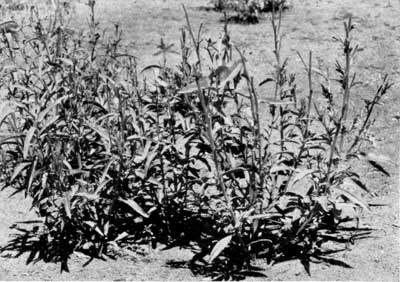 FIGURE 15. – Deer are particularly fond of the flower beds of Evening Primrose (Oenothera hookeri). They did not overlook one in these three clumps, though the plants grew inside a supposedly deer-proof fence. Photograph taken July 20, 1929, in Yosemite Valley. Wild Life Survey No. 186 |
The first protective move made was to fence a few acres around the Ahwahnee grounds to preserve the plant life. This was not really compatible with national-park ideals.
Physically incapacitated deer were dispatched, and this helped one aspect of the problem.
A third measure was tried with success. Deer had been practically exterminated from the Tuolumne watershed in a successful campaign to stamp out hoof-and-mouth disease in 1924. Two purposes could be accomplished by transferring deer from Yosemite Valley in the Merced watershed to the Tuolumne drainage, and this has been done for several seasons, the method being to entice the animals into a corral, then load them on trucks for immediate release at the destination. The transplanted animals have not tended to drift hack, so that the deer population of the valley is now more nearly within bounds.
Because a return of the mountain lion to the area is unlikely, due to the fact that all lions ranging in the park can be, and are, taken outside the boundaries, transplanting of deer may have to be more than a temporary measure of relief. However, throughout the park system the Service's policy of strict protection for predatory species is doing much to avert similar problems.
PROBLEMS OF GEOGRAPHICAL ORIGIN
FAILURE OF PARKS AS INDEPENDENT BIOLOGICAL UNITS
The preponderance of unfavorable wild-life conditions confronting superintendents is traceable to the insufficiency of park areas as self contained biological units. In the present era of park development, this geographical cause ranks as the most important of the three major causes of wild-life problems. If the influx of visitors were to increase in the future at the same rate that it has in the past 15 years, competition between man and animal in the park could easily become more influential in faunal maladjustments than the geographical factor.
At present, not one park is large enough to provide year-round sanctuary for adequate populations of all resident species. Not one is so fortunate – and probably none can ever be unless it is an island – as to have boundaries that are a guarantee against the invasion of external influences. To all this the practical-minded will immediately retort that an area with artificial boundaries can never be a true biological entity, and obviously this is correct. But it is equally true that many parks' faunas could become self-sustaining and independent if areas and boundaries were fixed with careful consideration of their needs. Already many parks are being improved in this regard, and there is a vast amount more that can be done.
When all advisable enlargements and boundary corrections have been made, there will still be external influences and probably some range in adequacies to be reckoned with and some management measures will be necessary for the protection of the affected species. Whereas both general types of problems due to the inadequacies of parks as independent biological units must be met primarily by changing the boundaries, as the only means of dealing with the fundamental cause, success can not be as great in one instance as the other. By his action, man can restore a needed range to a park provided he is willing to do it, but there is absolutely no way he can keep every unfavorable influence out of that park – not so long as boundaries are artificial, and some of them must always be that.
CONDITIONS CAUSED BY FAILURE TO INCLUDE THE COMPLETE ANIMAL HABITAT
Unfortunately, most of our national parks are mountain-top parks. During the summer, game retreats to the higher elevations. With the coming of winter the game drifts down below the park, away from protection. For a wild-life preserve this is obviously an unsatisfactory condition. It is utterly impossible to protect animals in an area so small that they are within it only a portion of the year. It is just as fundamental to protect the whole range of the resident fauna of any park as it is to protect the watershed of any stream for its water supply. One would not think of just protecting a narrow zone across which the water flows, but would extend the protection to the natural boundaries of the watershed. In like manner, it is useless to draw up imaginary and arbitrary boundaries for a park and expect to protect the animal life drifting through. This is exactly what has been done in creating the national parks – a little square has been chalked across the drift of the game, and the game doesn't stay within the square. In order that our parks may be able to adequately protect and preserve their wild life as part of our national heritage, it is essential that they be formed principally of natural boundaries, and not arbitrary boundaries. Natural boundaries in this case mean natural barriers limiting the range of the wild life concerned. While the natural boundaries are not definite lines, they are sufficiently tangible in character to be capable of practical establishment. It is now, perhaps, too late to establish natural boundaries completely around all parks, but that is no reason why they should not be established where it is still possible.
If natural boundaries are natural barriers limiting the range of the wild life of any particular area, more definite designation of what these natural barriers should be is necessary. The natural barriers are different for each park, and must be treated as individual problems in each case. But if there is any value in a generalization, this much might be said: As a natural barrier, a mountain crest is better than a valley or stream, but the lowest zone inhabited by the majority of the park fauna is probably the best of all.
All of the western parks are mountain areas. Some of them are a fringe around a mountain peak; some of them are a patch on one slope of a mountain extending to its crest; and some of them are but portions of one slope. All of them have arbitrary boundaries laid out to protect some scenic feature. But our national heritage is richer than just scenic features; the realization is coming that perhaps our greatest national heritage is nature itself, with all its complexity and its abundance of life, which, when combined with great scenic beauty as it is in the national parks, becomes of unlimited value. This is what we would attain in the national parks. In order to attain it, their boundaries must be drafted to meet the needs of their wild life. The entire complexity of wild life can be protected only within natural barriers. In establishing the boundaries, natural barriers should be followed.
Because so many of the national parks are in the high mountains, the seasonal habitat usually lacking is winter range. One exception where the reverse is true is Grand Canyon; but as it is such an uncommon case, it is discussed under that park only. Lack of summer habitat is not one of the major types of wild-life problems.
ANIMALS CUT OFF FROM WINTER RANGE (5)
Situations where park animals are suffering from lack of winter range must be met by extending the area to include the needed habitat if there is any possible way of doing so. There is an alternative in management, but it is a poor expedient at best, having several unfortunate consequences of its own. Artificial feeding is expensive. Concentration at feeding stations is a potential for the spread of disease. There are unguessed possibilities for harm in wild animals. Besides, holding game herds in the higher altitudes of deep snows exposes them unduly to carnivores. This means that additional management to protect them against the unnatural and excessive exposure to their enemies is required; and it is always undesirable to create a condition which necessitates interference with the predatory species in a park. The so-called northern elk herd in Yellowstone is an example containing all the elements of this type of problem, but it has been ably covered elsewhere by William Rush 10 in his 3-year study of this herd. Consequently, another example has been chosen for treatment here.
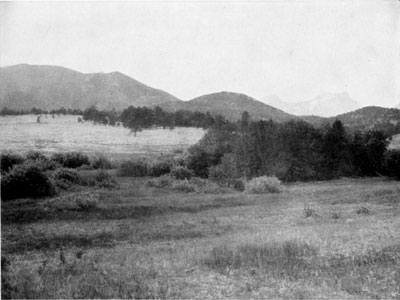 FIGURE 16. – One of the meadows in Beaver Park frequented by the park elk and a necessity to them in winter. Photograph taken June 26, 1931, in Rocky Mountain. Wild Life Survey No. 1895 |
Elk range in Rocky Mountain. – American wapiti were so abundant in this section in early days that market hunters took them out in wagonloads. They were almost exterminated and were later reintroduced from Yellowstone. There are now believed to be approximately 350 in the area, and Rocky Mountain National Park is already faced with an elk problem.
Elk on the east slope require the grasses at the edge of timber and above for summer range, the forested middle slopes for protection and calving, and the open valleys lower down for winter range.
The present park has suitable area for the first two requirements, but none for the third, which is, of course a critical one.
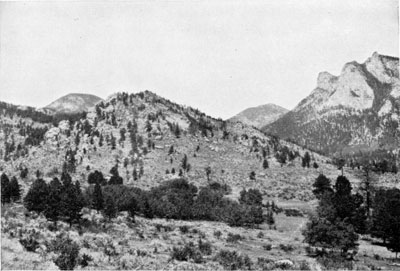 FIGURE 17. – The mouth of Black Canyon supports stands of antelope brush (Purshia tridentata), aspen, and other browse vital to elk and deer in winter. Photograph taken June 26, 1931, in Rocky Mountain. Wild Life Survey No. 2425 |
The eastern boundary is intersected by a series of open mountain valleys which are privately owned and therefore lie outside of the park proper. These valleys, including Estes Park itself, are the natural and only available winter range for the elk. They drift down into these parks in winter, destroying fences, gardens, hay stacks, etc. Consequently, they are very much disliked locally. In harboring the animals the Park Service accepts a responsibility that they should not be a nuisance to the countryside. If the problem is not met squarely, and, as a result, the elk are looked upon as a liability instead of an asset, both the elk and the cause of conservation will suffer.
The crest of the foothills just east of Estes Park would be the most nearly ideal natural boundary for the park; but for a long time to come the best that can be hoped for by way of a solution is to purchase the private holdings in the small higher valleys, namely, Moraine, Beaver, and Horseshoe Parks and Black Canyon. The program of enlarging this section of the park is being carried on at the present time. This is the first and most important step in the solution of the problem, but it is by no means the last. The meadows in these parks have been heavily grazed by domestic stock, mostly horses, for years. As the lands are acquired, a range-management plan is being formulated for the restoration of the range to its former high carrying capacity.11
During the winter of 1930 aspen was extensively barked by the elk. This was the first indication that the elk herd was reaching the limit of its food supply and that range abuse and starvation were in the offing. If this is happening when there are only 350 elk in the park, it is indication that even with the addition of the valleys above mentioned there will be a definite limit to the population of this species that Rocky Mountain National Park will be able to support without endangering both park and elk. The situation will have to be carefully watched, and increase beyond the allowable maximum checked if natural balances are not effective.
To sum up, this problem is caused by failure of the park to include all the seasonal habitats of the elk. The basic cause will be largely corrected by extension of boundaries to include winter range. This will have to be followed, as a second step, by a temporary range-management plan to restore the vegetative cover on the added lands to their vigorous primitive condition. Beyond that, a third step in the form of artificial control may be necessary if the elk continue to increase without reaching a natural balance. Within an area as small as Rocky Mountain Park it is unlikely that a natural balance ean be established, hence the excess above a safety point will have to be disposed of in some way.
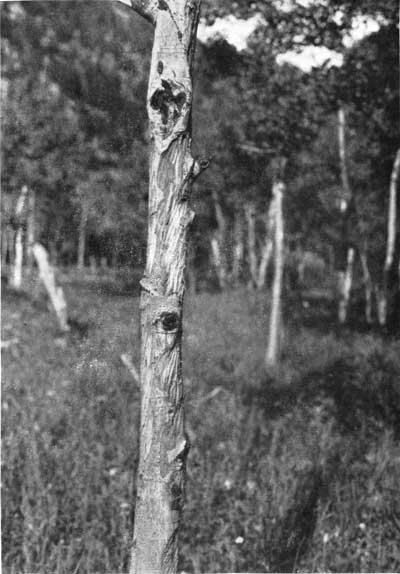 FIGURE 18. – Aspen barked extensively by elk for the first time indicate that shortage of winter forage is beginning to be felt. Photograph taken June 24, 191, at Fall River Lodge, Rocky Mountain. Wild Life Survey No. 1928 |
10 Final Report on Elk Study, Northern Yellowstone Herd, by Rush, W. M. Yellowstone Park, Wyo., 1932.
11 Report on Conditions of Portions of Elk and Deer Winier Range in Rocky Mountain National Park, by McLaughlin, John L. Rocky Mountain National Park, Colo., Jan. 15, 1932.
CONDITIONS CAUSED BY EXTERNAL INFLUENCES
The extent to which the fauna of any particular park suffers from adverse external influences depends upon three factors, namely:
(a) How much the fauna in the surrounding territory has been altered from its primitive condition.
(b) How adequate the area of the park is.
(c) How nearly the park boundaries follow natural barriers.
Every park is surrounded by territory in which the wild life has been greatly changed, but in some cases the aridity of the faunal life in such regions has become so great that the vitality of the park fauna is sapped at every boundary. Inasmuch as the external factor itself can not be generally controlled, resort must be had to improving the other two conditions. Increasing the size of the area and bounding it by natural barriers will help in many cases, but some encroachments, such as the spread of certain exotic plants or animals into a park, can not be stopped by any of these methods. Management measures to counteract these influences may be worked out in some instances, but there will be others where nothing that can be done is likely to correct matters.
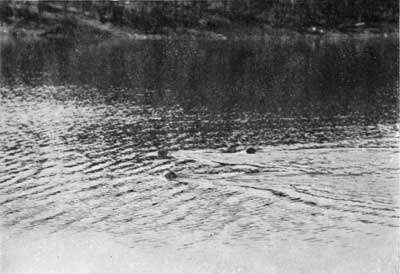 FIGURE 19. – River otter is one of the fur-bearers that can only be perpetuated in parks of large area. There are few places where the otter trusts man enough to play in the waters of a small lake while people watch from shore. Photograph taken July 10, 1931, at Bear Paw Lake, Grand Teton, by B. H. Thompson. Wild Life Survey No. 2424 |
CARNIVORES DRAINED FROM PARK BECAUSE BLACKLISTED OUTSIDE (6)
As regards their faunas, the parks stand in a peculiar relationship to the surrounding regions. Local residents in one breath praise the park as a breeding refuge for game to stock the countryside and in the next condemn it as a nest for the predatory species which they call vermin. The park standpoint is quite different. It has a special duty to protect the carnivorous forms which are blacklisted everywhere else. Game species do receive some consideration elsewhere, but the carnivores are insistently destroyed.
The draining away of the normal predator population is a more complex problem than just the loss of a member or two of the native fauna. It involves the danger of an abnormal increase in the ungulates which, in turn, involves abuse of the flora, and so on.
Because of their wide ranging habits and scarcity per unit area, it is relatively easy to almost completely deplete the smaller parks of these blacklisted species. Consequently, solution of this type of problem is to be sought in enlarging the size of the park. As the predators are generally less restricted by natural barriers, little can be done for them by merely changing boundaries without greatly extending the protected areas. In the case of mountain lions and wolves, especially the latter, it is doubtful if there is at present any park large enough in which they may be saved. The mountain lion is tenacious and may hang on in this country for a long time, but the wolf is already close to extermination. There is little likelihood that protection would be granted to wolves in areas adjacent to the parks, so they probably will go entirely. The coyote, on the other hand, prospers in spite of man and does not constitute a problem in this regard. Some of the smaller carnivores, including many fur-bearers, such as wild cat, fisher, wolverine, badger, otter, etc., may be saved by enlarging the parks and perhaps by providing some other protective management measures.
Wolverine in the parks of the United States. – As the example selected for problems of this type, the wolverine can be best treated by considering its status in all the parks of the United States in which it was a native. Comprehension of this question depends upon appreciation of the relation the parks bear to the status of the species as a whole.
Among our animals the wolverine is one of the most unique and interesting. On the other hand, it has been one of the most persecuted because of its fur value and also because of its annoying habit of robbing trap lines. This persecution continues in the areas surrounding the parks where wolverines are still found and, owing to their wandering habits, keeps them drained away so that they will soon disappear from these last stands.
According to records of past conditions, the wolverine was never so abundant in the United States as in Canada, being restricted to the higher life zones. It is almost gone from this country now. There are a few wolverines in Sequoia National Park (estimate of nine in superintendent's 1931 report), perhaps more than in any other of our western parks. The wolverine of Sequoia is a different species than the Canadian wolverine. In Yosemite, Grinnell and Storer report the capture of two wolverines at the upper end of Lyell Canyon in July, 1915. At several other places in the park, tracks were seen which they ascribed to wolverine.12 In July 1929, a wolverine track was seen in moist sand near Saddlebag Lake, just outside the boundary, by our party.
There seems to be no indication or record of wolverine in Lassen Volcanic or in Crater Lake National Parks. At Mount Rainier tracks of wolverine are occasionally seen. October 3, 1930, our party saw tracks of wolverine on Burroughs Mountain, by Sunrise Park. In Glacier National Park, Vernon Bailey13 reports a few trapped and killed at various places in the park between the years 1895 and 1910, but doubts whether any are present now, although he stresses the possibility of their wandering in from elsewhere. In the Yellowstone-Teton region, a few wolverines may still be present. They have been trapped outside of the parks, and occasionally tracks are seen. In Rocky Mountain National Park they were present in moderate numbers during the pioneer days of that region, but none has been seen in or near the park for many years, and they are believed to be gone from the region.
The foregoing data give a general picture of the present status of wolverines in those western parks where they should naturally be. It is evident in each park that their numbers have greatly decreased, this decrease being primarily due to trapping, the direct agency of man.
What can be done? There are several things which would help the wolverine to come back.
(a) Consciousness of the problem is the first step. Without being aware of the plight of our fauna, nothing could even be tried.
(b) Since wolverines are great wanderers, it would be well to consider the requirements of their range in establishing or completing boundaries. Enlargement of park areas in the upper Canadian and Hudsonian zones would increase their chances greatly.
(c) As most of the parks concerned could not be made large enough to be ideal in this respect, a protective zone, free from all hunting and trapping, might be established around each park as a further safeguard.
(d) Special attention could be paid to the matter of protection from poaching for this and other species known to be in danger. This does not mean that the parks are not patrolled; it merely means that an added emphasis should be placed on protection in these cases.
(e) If all means of encouragement and protection should fail, then in some instances it might be possible to procure and liberate a few pairs for breeding stock. This would be especially desirable in the Rocky Mountain parks, where the common wolverine (Gulo luscus) could be planted. In the Cascade-Sierran parks, no introduction of stock should be even considered until the ranges of the common and southern (Gulo luteus) forms are more definitely worked out. If an intergradation of these two forms should occur in this region, it would be especially valuable, scientifically and educationally, to do nothing that would disturb this natural blending of species. If the wolverines in this area should continue to decrease, then it might be justifiable and necessary to choose breeding stock from the nearest range of the native species for reintroduction into the parks concerned. The feasibility of trapping and transporting wolverines has been demonstrated in the securing of a number of these animals from Alaska for the zoological gardens at St. Louis, Mo.
12 Animal Life in the Yosemite, by Grinnell, Joseph, and Storer, Tracy I. University of California Press, Berkeley, Calif., 1924, pp. 85-86.
13 Wild Animals of Glacier National Park, by Bailey, Vernon, and Bailey, Florence Merriam. National Park Service, U. S. Department of the Interior, 1917, pp. 90-91.
ENCROACHMENT OF EXOTIC SPECIES UPON THE NATIVE PARK FAUNA (7)
This is a situation which is not apparent in many parks at present, but which is apt to become more and more difficult. There are three ways in which man has brought about the introduction of exotics.
(a) Many imported species of animals, notably game birds and fishes, are liberated all over the country each year in the interests of sportsmen.
(b) Exotic species are constantly being liberated by accident.
(c) Certain animals native to one part of the country actually flourish with civilization and invade new ranges in the wake of man. These are exotic in their newly occupied ranges, too.
If any animal introduced by any of the above means takes hold and spreads into a park, serious complications are bound to ensue, for such an animal would not increase if it were not able to displace another form or compete successfully in the utilization of a valuable food supply. Aside from the direct competitive effect, such introductions may have indirect influences, such as disease introduction and production of crossbreeds, but these are treated separately below.
Fortunately, most of the foreign game introductions have not been notably successful. However, captive animals which are liberated, perhaps accidentally, and do take hold are a real danger. Their vigorous adaptive qualities are a menace to native wild life. The opossum, which has recently arrived in Sequoia National Park, is an example. The same is true of the animals which thrive and spread where man goes. They are exceptionally adaptive and aggressive, or they would not have been able to go with him. Certain ground squirrels and the coyote are notable examples.
Effective ways of dealing with this type of problem remain to be discovered. The size of a park is of no avail and such species do not recognize many natural barriers. It is to be hoped that some practical means of preventing encroachments will be found before it is too late.
Coyote in Mount McKinley. – The spread of the coyote is a difficult and insidious problem. The reasons for its sudden spread over vast new territories are too controversial to be discussed here, but this outward movement is certainly associated with the changes which human populations have wrought. In Mount McKinley National Park its invasion is looked upon with great alarm.
Regarding the spread of the coyote, E. A. Goldman14 says:
"Formerly they occupied the western plains and basal mountain slopes from western Canada and the United States south over the tableland of Mexico, and the tropical savannas along the Pacific coast as far as Costa Rica . . .
"In recent years coyotes have pushed northward, however, from British Columbia and Yukon Territory into the Yukon Valley and are reported to have reached Point Barrow, Alaska, and the mouth of the Mackenzie River in Canada . . .
"According to a resident of Telegraph Creek near the Stikine River, Canada, no coyotes were known in that section prior to 1899 . . .
"The movement into new territory evidently began in early days. Vernon Bailey states that coyotes were absent from parts of southeastern Minnesota prior to 1875 when they first appeared in Sherburne County, presumably from the great prairies west of the Mississippi River. When they became common, the red foxes, formerly numerous, practically disappeared . . .
"Coyotes entered the upper peninsula of Michigan about 1906, and have even gone into forested sections near the coast in Oregon . . .
"They are also being reported from localities east of their former habitat on the western plains. . . . Small colonies are reported in western, central and southeastern Alabama."
In his field notes, Dixon reports the skull of a coyote which was killed at Mount McKinley Park in 1926. Since that time the coyote has been gradually encroaching on the park. Similar experiences elsewhere indicate that it will tend to displace the abundant Alaska red fox, and perhaps the wolf, too, in the only national park where that animal still figures. The effect of a new and formidable enemy upon ptarmigan, curlew, mountain-sheep lambs, caribou calves, etc., can only be conjectured.
Mr. Stokley Ligon's analysis of the problem, which applies here very well, is essentially this: The coyote is beneficial in its own range and habitat; but when it gets outside of its own range, as it has done many times, it becomes a different animal and is destructive.
First of all, it is the aim of the National Park Service to maintain primitive conditions in the national parks. If this is to be accomplished, the coyote, where it is native to the park (it is clearly not native to Mount McKinley), has as much right as any other member of the park fauna. It is to be considered just as worthy and desirable as elk, moose, or deer. Indeed, when it is seen, it is a great attraction. There is sometimes a tendency in men in the field to hold any predator in the same disreputable position as any human criminal. It seems well to comment that no moral status should be attached to any animal. It is just as natural (just as much a part of nature) for coyotes to prey upon other animal life as it is for trees to grow from the soil, and nobody questions the morality of the latter. This is one angle of the situation.
The other side is that in relatively small areas, such as Mount McKinley and Yellowstone, where the wild life is of greatest importance, it is impossible to preserve that wild life and allow the encroachment of exotic predatory species or of abnormal numbers of the native ones from the outside. The antelope and mountain sheep of Yellowstone could be easily exterminated and the loss would be great, whereas the coyote is of such wide distribution that its extermination in Yellowstone is not probable. Even if it were exterminated in that particular area, it would soon reinvade. Actually it is remarkably abundant, though some control work is carried on.
The logical course of action seems to be this: If coyotes are present in a park in greater numbers than formerly but give no indications of unusual damage, they should not be molested. We do not know enough about the causes of their increase yet to justify steps against it. In Mount McKinley, where the animal life is of great importance and where the coyote does not belong, every safe step should be taken against its encroachment as an exotic and an alien. In Yellowstone, where certain species such as antelope, mountain sheep, trumpeter swan, and sandhill crane need special protection, the coyote must be controlled. Mount McKinley and Yellowstone are at present the only parks where circumstances clearly justify coyote control.
Inasmuch as there is no way of preventing the invasion of the park at the boundary line, the word control is used advisedly. It is the only way to meet the coyote problem. The solution could be a satisfactory one if there were any practical selective method which could be used. Shooting is selective, but it is costly and not sufficiently effective for the coyote. Trapping is the next best. It is effective but not selective. In Mount McKinley the prized foxes and wolves, as well as wolverines and others, would suffer, too. Poisoning, of course, could not be allowed. It would be better to have the coyote. When a satisfactory method for taking coyotes without harming anything else is discovered, one of the most puzzling of all wild-life problems will be solved.
14 The Coyote–Archpredator by Goldman, E. A., Journal of Mammalogy, Vol. XI, no. 3, August, 1930, pp. 327-329.
DILUTION OF NATIVE STOCKS BY HYBRIDIZING (8)
The distribution of vertebrate life and correlation of speciation with geographic range is one of the most fascinating of zoological studies. The ranges of some forms were not even worked out before those animals were exterminated. This is true of the grizzlies. So many of the grizzlies are extinct that the taxonomy of the species will never be fully known.
But this is only part of the story. There is a great and growing tendency to transplant animals from one part of the country to the other without any regard to the native range of each form. This means hybridization of one subspecies with another and a gradual muddling until many forms are lost.
In the national parks it is especially desirable to preserve the pure native strains. This can not be done if related subspecies of the park animals are introduced in adjacent territories, and consequently the only solution for problems of this type is to seek for a reform in restocking practices. The only way to secure protection would be to designate a Federal commission or agency through which all stocks for transplanting purposes would have to be cleared.
Elk transplants from Yellowstone. – This needed reform in restocking practice might well start with the National Park Service itself. The elk of Yellowstone (Cervus canadensis canadensis) have been planted widely within the range of the other species and subspecies of this animal. There are Yellowstone elk in Rocky Mountain, Mount Rainier, Crater Lake, and the Guadalupe Mountains by Carlsbad. At the time the Yellowstone elk came to Rocky Mountain there were probably still native elk in the park. While it is true that they were supposedly of the same species, nevertheless any possibility of studying intergradations or races which might have existed is now lost. The Yellowstone elk in Mount Rainier have drifted in from the Cascades east of the park.15 Probably the original elk of Mount Rainier were the Roosevelt elk, and therefore any reintroduction should have been of this species. If there were ever elk in the Guadalupe Mountains, they were probably the Merriam elk, a southwestern species now extinct. In any event, there would be little value in having Yellowstone elk down in the Guadalupes. There are many who believe that the educational value of seeing an animal lies in the significance of that animal's relation to its environment and past history. When the species are mixed or replaced, there is nothing left but just another elk.
The purpose of this discussion is to bring up the question of Park Service policy on shipping breeding stock to alien localities. It so happens that none of the elk plants discussed above was made in the parks where the elk now exist. But they were distributed in response to outside requests. Because of their proximity, they drifted into the parks, and the results were the same.
The situation seems to indicate that the Park Service, in order to protect its different faunas, would be justified in establishing the policy of shipping animals only to points within their native range (museums and zoological gardens, of course, excepted).
Caribou and reindeer in Mount McKinley. – This is a striking illustration of the danger that an outstanding native park animal may be lost through hybridization with an exotic variety introduced in the surrounding region.
Ten reindeer from eastern Siberia were introduced into Alaska in 1891. By 1902, 1,280 reindeer had been imported. To-day these animals number about 200,000 in Alaska. Being very closely related to the caribou, they hybridize readily; so that the future status of the caribou is questionable. The reindeer industry has spread eastward across Alaska until reindeer are now at Broad Pass, just outside of Mount McKinley National Park. The caribou of Mount McKinley are one of its great values. While the Mount McKinley caribou are separate from the main caribou migration in the north and east, they are nevertheless a considerable band, of about 50,000, with a local seasonal migration, and they are so situated as to be on the reindeer frontier unless some measure is taken to keep reindeer away from the Mount McKinley area. In 1926 Dixon and Wright saw reindeer, caribou, and hybrids in the park. Now, with the stated aim of the industry to hybridize caribou and reindeer and the natural tendency for this hybridization to occur anyway, it becomes increasingly valuable to maintain the Mount McKinley caribou as a pure strain. The Park Service, the Biological Survey, and many others recognize this situation and are trying to prevent its unfortunate consequences. Whether anything can be done to save the Mount McKinley caribou, ultimately, is a question.
Aside from hybridization or driving out native forms, the great danger in all such introduction of exotics lies in the possibility of bringing in some pest on disease which would prove fatal to the native species. No reindeer plagues have occurred in Alaska yet, but we do not know the potentialities.
15 Mammals and Birds of Mount Rainier National Park, by Taylor, Walter P., and Shaw, William T. National Park Service, Department of the Interior, 1927, p. 116.
EXPOSURE OF NATIVE SPECIES TO DISEASES AND INFLUENCES OF ALIEN FAUNAS (9)
One of the fundamental principles governing the distribution of animal life is that when the faunas of two different continents meet, the fauna of the larger continent will be the survivor. There is abundant paleontological as well as present-day evidence substantiating this fact. When we bring domestic stock, particularly sheep and cattle, in contact with native game, we are exposing the native game to members of the Asiatic fauna. This brings in new diseases and new conditions with which the native fauna has not had to cope before, and the results are apt to be disastrous.
All livestock and wild game are subject to many different diseases and parasites. If an outbreak occurs in domestic stock, there are chances of its being controlled. If it gets into the native wild life, it is apt to run its course, with irreparable damage. There is one important exception to the foregoing statement, and that is the control of the hoof-and-mouth epidemic among deer in California, 1924. The plague was stamped out by killing 22,214 deer. But it is obvious that any such remedy would be fatal to mountain sheep, mountain goats, antelope, elk, moose, or any other rare forms of animal life.
It is not actually necessary for domestic stock and native game to come in contact for the damage to be done. Even use of the same range may be just as effective, for some of the most viable disease germs may be carried in the soil for years to start a new outbreak.
Because of the above circumstances, it is clear that the only way to treat problems of this type is to prevent possibility of their occurrence. This can be accomplished for species occupying a restricted range by keeping domestic stock out of a neutral zone between the two. This would work with mountain sheep or antelope, but not so well for deer or elk. Fortunately, the rarer species are the ones to which it is most feasible to extend this sort of protection.
Where a disease has already been contracted by a park animal there is but little that management can do so far as is known at the present time. The first step is to adjust the park boundaries so as to prevent reinfection through the same avenue. The spread of disease may sometimes be checked by destroying carcasses of infected animals. In another case the disease might be eliminated by destroying the alternate host where that host was not a rare form and could be counted upon to reinvade the territory later on when the disease had been conquered.
Sheep scab in Rocky Mountain. – There is some dispute concerning whether the wild sheep of America were subject to sheep scab before the introduction of domestic sheep, but the evidence seems to point to the fact that they were not. Numerous accounts tell of heavy losses of mountain sheep from sheep scab in the pioneer days of the sheep industry in the West. Merritt Cary16 says: "A danger which threatens mountain sheep in Colorado, as well as in other Western States, is the introduction of scab from domestic sheep allowed to graze on the higher mountain slopes." Warren17 says: "C. F. Frey tells me they suffer much from scab in the West Elk Mountains, and that a party told him in 1902, at one place near the head of Sapinero Creek, 75 head were counted which had died of scab. Domestic sheep had been run in that locality, and the wild sheep doubtless contracted it from them."
Aside from the question of origin of the disease, the fact remains that whereas domestic sheep may be treated and cured of sheep scab, there is no known way of dealing with it in mountain sheep. When the survey party was in Rocky Mountain in 1930 and in 1931 the mountain sheep were scabby. Reports of local residents indicated that scab had been present for many years, being worse in some periods than others. Domestic sheep had been run in these mountains for so long that it was not possible to determine definitely that the wild sheep were not subject to an endemic form of sheep scab.
The sheep situation in Rocky Mountain should be investigated thoroughly. In the meantime reinfection should be prevented by removing the domestic sheep as far as possible from the mountain-sheep range. The Never Summer Mountains addition has already been an improvement in this regard.
16 A Biological Survey of Colorado, by Cary, Merritt. North American Fauna No. 33, 1911, p. 62.
17 The Mammals of Colorado, by Warren, Edward R., 1910, p. 238.
PROBLEMS OF COMPETITIVE ORIGIN
CONFLICT BETWEEN MAN AND ANIMAL IN THE PARKS
Since he is in the parks permanently both as resident and seasonal visitor, man must henceforth be considered an integral part of those microcosms. The significant difference between himself and all other ecological factors is that he is conscious of his relationship to the other elements of the park world and hence can regulate, or at least modify, his influence to suit his own purpose. It happens that in the parks the purpose dominating man's relations to his environment is the maintenance of all the animal and plant life in an unmodified wilderness state. In order not to defeat his own ends, he contrives that his presence shall disturb the wild life to the very smallest degree that his ingenuity can manage.
This means that painstaking consideration for the welfare of the fauna must accompany the development of every phase of human occupation of the parks. Yet developments in the era just closed have not always been characterized by as much restraint as a delicate situation required. This was only natural in a time when the principal preoccupations were making the parks accessible, attracting the visitors to them, and making them comfortably at home while there. But in the era opening ahead, the critical faunal maladjustments that have already been created, as well as those just raising their heads, must be dealt with in a farsighted manner. For if the wild life continues to give back before the growing pressure, man will presently find that he has unwittingly destroyed the very thing which he came to the national parks above all other places to enjoy.
In considering the effects of man's intrusion in the total environment which is the park, it is apparent at once that certain faunal complications are inevitable, if for no other reason than the quantitative displacements which must take place. These problems are rooted in the conflict of the more fundamental needs of man and animals in the parks. As their cause is man's presence and that presence is not only continuing but constantly increasing, they must be treated accordingly. These problems are essential by-products of the sharing of a common habitat by man and animal.
There are other complications, however, which are not caused so much by man's actual needs as by his ideas of what wild animals are and how he should see them. Inasmuch as these are problems caused by human concepts which can be changed, they are subject to control at their sources. It is necessary to analyze these problems to fully realize that they arise from man's efforts to force the animal life to actually fit his concept instead of developing his concept to fit the wild life as it really exists in its natural setting.
These difficulties are more truthfully problems of human nature than of animal nature. In dealing with them it becomes necessary to enter the fields of philosophy and psychology, because, after all, the national parks are an experiment in these fields. Wherever he goes, man unconsciously tries to surround himself with the things to which he is accustomed. He abhors change. Consequently almost any labor in transplanting whole environments is found preferable to the effort of reconditioning to new circumstances and concepts. Coming from the city, man tries to approximate in the park the conditions he left behind. If his eye is met by a planting of his home flowers arranged in garden pattern, he praises it as a beautiful improvement unless his viewpoint has been reeducated to an appreciation of the park's own distinctive wild gardens, and then it becomes a jarring note on the landscape.
Generations ago man was accustomed to wild animals, but that has all been buried in city life. Whenever he has seen wild animals at all, they have been presented in some way compatible with dense populations. When he enters the park he is looking for the same concentration of animals he saw in the paddocks of the zoological garden, the same personal safety in feeding the tamed animals, the same convenience of driving to a known place at any convenient time to see what he wants. A galaxy of bears at the garbage platform approximates this concept and he is satisfied. Then comes a day when his heart skips a beat. Walking along a deep forest trail he comes upon a single bear eagerly peeling the bark from a log in search of fat white grubs. This is a fresh thrill and it brings the realization that the unique charm of the animals in a national park lies in their wildness, not their tameness, in their primitive struggle to survive rather than their fat certainty of an easy living. The new concept. involves an appreciation of the characteristics of a real wild animal, notably, that each wild animal is the embodied story of natural forces which have been operative for millions of years and is therefore a priceless creation, a living embodiment of the past, a presentiment of the future. It teaches the new joy of seeking out the wild creatures where they are leading their own fascinating lives instead of having them pauperized in camp where each individual animal becomes a bull in a china shop.
The change from urban to wilderness concept of the presentation of wild life will remove the cause of many wild-life problems. The Service has developed an educational branch dedicated to this very task of bringing to man a true appreciation of national-park values; and as its work becomes more and more effective, it will remove the desire to improve wild life where such improvement is detrimental not only to the fauna but, in the last analysis, to man's interests as well.
In the following treatment of some of the major types of problems it is granted that the actual maladjustments exist. Whether they are problems which could have been avoided or not, they all must be faced. It seems best to deal first with species which actually interfere with human occupation.
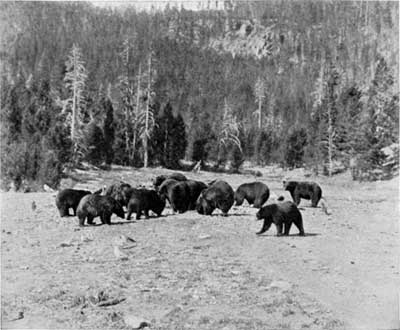 FIGURE 20a. – Black bears at a feeding station are spectacular but the scene does not typify the finest park values. Photograph taken September 11, 1929, at Canyon Lodge, Yellowstone. Wild Life Survey No. 448 |
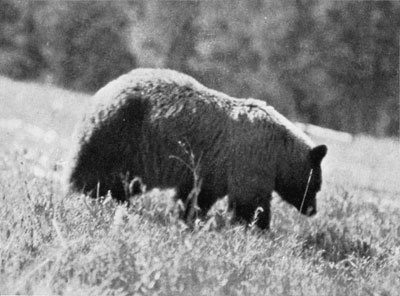 FIGURE 20b. – A single bear feeding naturally on grass in a glade presents a more pleasing and, because of the wildness of the whole setting, a more thrilling picture. Photograph taken June 21, 1930, at Crescent Hill, Yellowstone. Wild Life Survey No. 962 |
ANIMALS HARMFUL TO MAN
A very few park animals are dangerous to human life. A few more are merely offensive. More often, animals are injurious to property or to some special landscape feature needing special protection. In nearly every instance the damage occurs only under certain conditions and no species except certain poisonous reptiles are to be considered dangerous at all times. Whenever it is necessary to act at all, man's retaliation should be governed by a full realization that his ultimate interest in the park is best served by preserving its fauna intact. Therefore, first and always, some means should be sought which will give protection against the damage without hurting the status of the animal which caused it. If fish-eating animals, woodpeckers, bears, deer, elk, beavers, skunks, wood rats, and others were destroyed whenever they were a nuisance, the parks would be comfortable surely, but they would resemble city, more than national parks.
UNUSUAL DAMAGE TO LANDSCAPE (10)
In general, the normal utilization of vegetation by the herbivores is no concern in administration. There are exceptions, however. These occur in two cases.
(a) Certain trees and shrubs growing naturally may be located at strategic points which make them individually so valuable to man's interest in the park that his interference to prevent their destruction is justified.
(b) Where man has resorted to planting to restore a landscape which he has defaced, protection of the newly set trees and shrubs often becomes necessary, as they are particularly subject to attack by animals.
The more planting that is done in a park the more faunal complications there will be. This is an additional argument for keeping artificial landscape planting in national parks to the minimum. Some landscaping is essential in order to reestablish the native cover destroyed in the construction of buildings and roads. This applies not only to new projects but also to eradication of scars where an old road or building area is abandoned. Transplanted vegetation is in a precarious condition until it becomes established in the new location. Because it is more succulent than the older forage, and perhaps for other reasons as yet not understood, it is apt to be demolished by deer, elk, rabbits, squirrels, porcupines, and other herbivores.
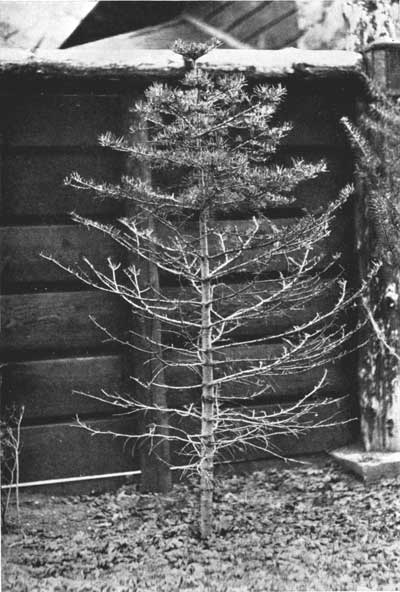 FIGURE 21. – White fir at the Hotel Ahwahnee grounds, Yosemite Valley, heavily browsed by deer. Trees and shrubs transplanted for necessary landscaping purposes have to be temporarily protected against such depredation. Photograph taken March 29, 1930. Wild Life Survey No. 562 |
The proper approach to problems of this type is to anticipate the damage in any locality by choosing the less palatable species, using sufficient seed or stock to allow for an estimated loss, or planning whatever else can be done toward meeting the difficulty from the botanical angle. It is to be hoped that the future will develop a useful management practice of this type.
The second way to meet these problems is by seeking some method of protecting the vegetation from attack. Temporary screening or fencing is expensive and incongruous on wild landscape, but it may be permitted in exceptional instances, say for a period long enough to establish shrubbery or trees in administrative centers. If rapid-growing species are used, the plants will soon be above browsing height or sturdy enough to stand full exposure.
Considerable experimental work has been carried on to discover repellents. Napthalene bags hung among the branches are said to be successful in deterring deer, but this is still in the experimental stage. Fish oils and other sprays have been tried, but these wash off quite readily.
The third possibility, and absolutely the last to be considered, is destruction of the individual offending animals. In a park, the larger vertebrates are usually prized above all other forms of wild life. Hence to kill an animal to save a plant is likely to be a cure more awful than the disease. If a careful consideration of all factors reveals that it actually will be a benefit to the whole of the park to remove the destructive animals, the usual precautions should be exercised in taking only the individual offenders and not risking the status of the species.
The discussion thus far has been limited to instances where the fauna was normal and the flora abnormal. But the problem may also be due to an abnormal faunal condition. Such is the case where the ungulates are unnaturally abundant, and this takes place frequently in the very population centers where landscaping is most necessary. The floor of Yosemite Valley is an excellent illustration of this. In such instances, the remedy of the situation lies first in restoration of the normal range-fauna relationship – a question treated elsewhere in this section.
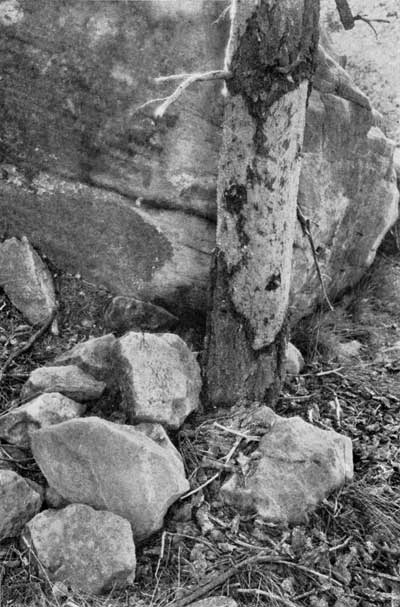 FIGURE 22. – Piñon girdled by porcupine. Note bark chips on the ground. Except in particular locations, such as this at the foot of Cliff Palace where large numbers of trees have been ruined, the value of the porcupines is greater than that of the few trees killed by them. Photograph taken November 10, 1930, at Cliff Palace, Mesa Verde. Wild Life Survey No. 1537 |
Porcupine in Mesa Verde. – This is chosen for a specific example of animal injury to landscape because it involves both classes of such damage; namely, to natural growth of woody plants having an unusual value to man, and to plants transplanted for landscape improvement.
In the past few years porcupines have increased until their population is far above normal for the mesa. Such infestations of this species occur from time to time in various parts of its range from causes which as yet are unknown. Most unfortunately for man in the park, porcupines have congregated in the moist draws, destroying piñon pines that are of particular value to the essential interests of Mesa Verde as a national park.
One instance is in Cliff Canyon, directly below Cliff Palace, which is the major one of the ruins. By 1930, porcupines had barked the trees in this fine stand of piñon to the extent that many of the trees had died. There were 240 piñons in the area, over 150 of which had been damaged. It was estimated that one-third of the stand was already doomed, and the abundance of fresh gnawings pointed to the practical destruction of the entire grove in the near future.
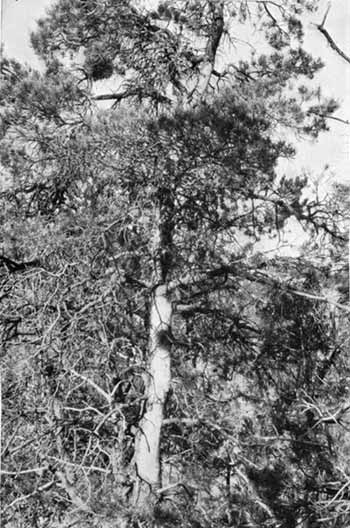 FIGURE 23. – Cliff Palace piñon gnawed in 13 places. Trees like this, not actually girdled by the porcupine, are so weakened that they succumb to disease or insect attack. Photograph taken November 10, 1930, in Mesa Verde. Wild Life Survey No. 1538 |
The picturesque and natural setting of the Cliff Palace was definitely impaired. Furthermore, any destruction of the natural cover on the steep canyon slope immediately underneath endangers the preservation of the ruin by increasing the erosion. The cliff dwellings are the one and only reason for the establishment of Mesa Verde National Park and are to be protected above everything else on the mesa. At this location, the decision to remove a number of the porcupines was determined by the archeological values at stake.
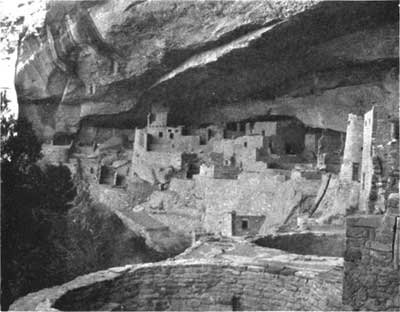 FIGURE 24. – The piñon grove is an essential part of the Cliff Palace picture, and this natural growth is necessary in checking erosion on the steep slope which supports the ruins. Photograph taken November 10, 1930, in Mesa Verde. Wild Life Survey No. 1607 |
The porcupine have created a second problem in Upper Soda Canyon near scenic Park Point on the entrance road. Piñons are very scarce at this end of the mesa, so that certain individual trees have a great landscape value. Considerable effort has been expended to save those taken from the right of way on the new road by transplanting them to heal the old road scars. In the draws along the road at this point, the concentration of porcupines was rapidly eliminating both old and young trees, so that with the passing of the ancient and picturesque weather-scarred veterans there would be no second crop to replace them. Rather than lose trees which it cost a great deal to transplant and others which were preserved with great care when the road was constructed, it seemed preferable to remove the marauding porcupines.
Control work in both instances was accomplished by shooting the porcupines just at those points. In this way no other species was involved and an exact check could be kept on the number of animals taken. Not the slightest chance was taken that the porcupine would be eliminated from tIme fauna of the park as a whole. Further, the species dealt with was not one in any danger of becoming extinct.
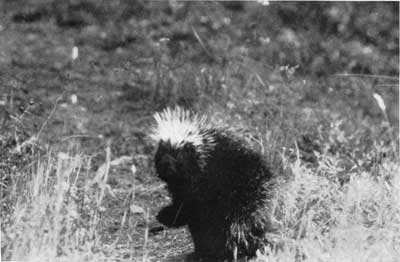 FIGURE 25. – The porcupine discovers someone coming up the trail behind it. One of the most interesting of wild creatures, it should not be controlled in any park except in the most extreme cases. Photograph taken August 19, 1931, at Rogers Lake, Glacier. Wild Life Survey No. 2384 |
CONFLICTS WITH FISH CULTURE (11)
Fishes constitute the only wild-life resource which is harvested in the national parks. Because of this, the administrative relations involved have a unique aspect. Wild flowers are to be enjoyed in place and the timber in the trees is not to be utilized. No animal is hunted, and only the fish is angled from its native waters. Fish culture is practiced to prevent depletion and to extend the pleasures of the sport to waters not naturally stocked.
It is not the intention here to question the merit of this important exception to general policy, for, admittedly, the direct benefit to man overrules the disadvantages which are incidentally incurred. However, it seems fitting to pause, before taking up the faunal complications involved, long enough to register a plea that in each park one watershed shall be set aside for the preservation of the aquatic biota in its undisturbed primitive state. In these areas there would never be any planting of fish or fish foods, and fishing would be carefully regulated so as not to deplete the breeding stock. The time is rapidly approaching when these would be the only places on the continent where the native trout could be seen and studied in their primitive haunts unmodified by human influence.
Perhaps the immense value of preserving certain wilderness waters can be best emphasized in the recounting of an incident which took place some years ago. It happened on the occasion of a pack trip in the upper Kern Canyon, California. A member of the party who was a prominent citizen of this country was about to fulfill a lifetime ambition to catch golden trout in its native stream. He had traveled nearly 3,000 miles and tramped a few more weary ones expressly for this purpose. This man was no ichthyologist, merely a devotee of Izaak Walton who had sampled noted trout waters in all parts of the earth.
On a bright morning one of the writers scrambled up the steep walls of Volcano Creek with the one who was going to realize his dream of gold. But surprisingly enough, he chose to take only two trout. They were laid side by side on the green bank, turned over and over, admired and carefully compared. Fishing was good, but why steal more from this precious source when the interest lay in catching a trout in this particular stream and not in the weight of the creel? This was a new concept to the writer, and since that day limits have no longer been the measure of successful fishing days.
There is a very special joy in finding out streams where there are native trout undisturbed by any artificialities. Wilderness streams would always provide this thrill in addition to serving as scientific laboratories. It is to be hoped that suitable reserves for fish will be set aside in the parks before it is too late.
Wherever trout are planted it is inevitable that birds and mammals will take a certain percentage of the total. Since man spends money and effort to place fish in streams and lakes, and intends them for his own use, he is dismayed when others share in the feast, enjoying meals that he has already bought and paid for. Yet it would be destructive of major national-park values to kill otters, ospreys, mergansers, kingfishers, mink, gulls, bears, loons, pelicans, and others, in order to prevent losses from those sources.
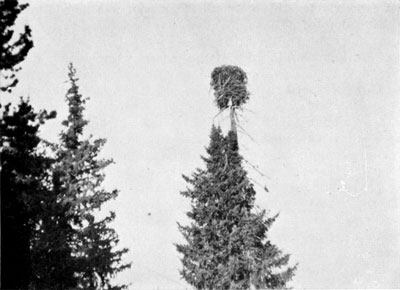 FIGURE 26. – The osprey nest on the east entrance road attracts the attention of thousands of park visitors. The toll in fish is made up many times in the enjoyment this bird brings to all classes of visitors, including the fishermen. Photograph taken June 10, 1930, in Yellowstone. Wild Life Survey No. 603 |
Inasmuch as fishing robs the fish-eating animals of their normal food supply, it would seem perfectly proper that a fair proportion of the output of the fish hatcheries should be allotted to them. Members of the fishing fraternity would be the first to grant this concession in return for the unusual privilege that is theirs in having their sport in areas otherwise closed to hunting. Nor can the problem of conflict between fish culture and the animals dependent on fish ever be solved satisfactorily until the principle is recognized that man must raise trout for the wild life as well as for himself in national parks.
This does not mean that precautions against excessive depredations can not be taken. The most effective of these is to hold trout in rearing ponds until they are at least 6 inches in length, which, after all, is only practicing what fish culturists advocate as the proper restocking method anyway.
Occasionally bears raid fish traps. This is a special form of damage which has been met successfully by surrounding the inclosures with live wires. A consistent offender that refused to be put off could be destroyed or trapped and shipped away. The same treatment of taking the life of an individual bird or mammal inflicting abnormal havoc may be permissible at other times, but it should always be a special case with certain proof of guilt at hand. To wage war against a species would be to sacrifice the whole purpose of the park to one special interest.
Red-breasted mergansers in Glacier. – Glacier National Park abounds in good fishing. Mergansers were seen on a few occasions by the survey party during five weeks of travel in the park. The relative scarcity of these birds in what seemed to be such ideal ground for them was the subject of comment.
A family of five mergansers was reported to be active in the immediate vicinity of a recent planting of trout at Red Eagle Lake. A trip to the lake revealed the presence of the following: Water ouzels, one of which was seen with a small fish grasped firmly in its mandible; kingfishers, which were common; one osprey; mink tracks; and the merganser family.
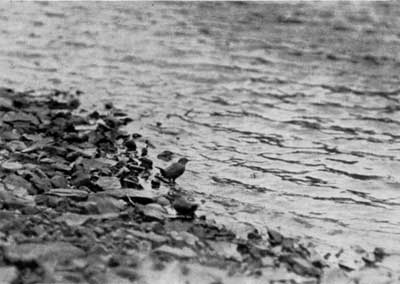 FIGURE 27. – Even the beloved water ouzel stole trout from this fishing water. Photograph taken September 5, 1931, at Red Eagle Lake, Glacier. Wild Life Survey No. 2200 |
Admittedly, mergansers consume large numbers of fish. Nevertheless, the killing of five mergansers could not be condoned except as a last resort. It would be better to try every other possible means first. Planting larger trout would help. Distributing them all along the shore instead of at one or two points would minimize the concentration of the fish and hence lessen the loss. Then there is still the possibility of keeping the mergansers off for a few days until the planted fish have established themselves in their new surroundings. This is a problem worthy of careful study to devise a better solution than destroying a valuable park bird.
ANIMALS INJURIOUS TO LIFE OR PROPERTY (12)
In the national parks man enters into close contact with the fauna, a different relationship from the one that has prevailed for thousands of years. But only one party to the age-old conflict has agreed to a cessation of warfare. It is the altruism which always rides more easily on the brow of the victor. The animal life has not developed any altruism. It must continue to fight for its existence, always motivated by the necessity of the moment.
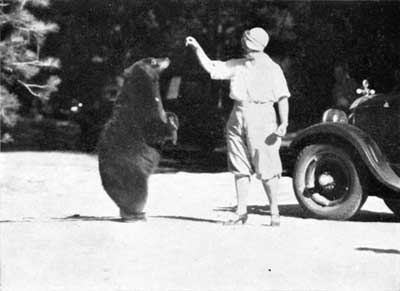 FIGURE 28. – When unarmed people invite intimacy with a large powerful animal such as the black bear, injuries are sure to result. Photograph taken November 3, 1929, in Yosemite Valley. Wild Life Survey No. 22 |
It would be profitable in meeting the problems which have resulted from this new situation to analyze the human-animal relationship further. The larger animals are physically more powerful than man, better equipped with natural weapons of defense and offense. On the other hand, man's intellect has devised weapons so effective that some animals have become extinct, and many others would be, if man himself did not have a different purpose. In addition to the older purpose of using up and destroying the wild life about him, man has recently discovered a new purpose, which is to utilize the fauna in certain localities by saving it in its natural state for the recreational and scientific benefits. Wilderness preserves such as national parks perform this function.
Consequently, when visitors enter national parks their old weapons and purpose are laid aside. They come into a new contact with animal life in which they have no means of defense but in which the animals still retain their weapons. As a result, every year a few visitors are injured from this new contact which they do not quite understand. It really happens from a failure to realize what a wild animal is, and to keep alert to the fact that the animal can not have a knowledge of the game as it should be played in a park.
As man's purpose is to leave the fauna undisturbed, the proper attack for problems of this sort is through education of the park visitor to an understanding of how to make the new sort of contact with the wild life. So long as people without weapons of defense invite too close an intimacy with animals that are well armed, injuries are sure to result.
Destruction of property and too close association with offensive animals, such as skunks, can be averted by the use of human ingenuity in inventing protective devices. The additional expense involved is justified in the same way that costly road building is justified, namely, the preservation and development of the values for which parks are created. Here, as elsewhere, in meeting wild-life problems the death penalty should be the last resort. It is only necessary in rare instances and should never be directed against the whole population of any species. The rattlesnake is the only candidate to be indicted so far, and even it should not be condemned without fair trial.
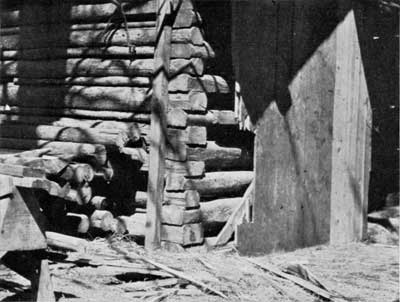 FIGURE 29. – Barn broken into by grizzly searching for oats. If bears and man are to live in close proximity, buildings containing food will have to be made bear proof. Photograph taken September 14, 1929, at Lake Lodge, Yellowstone. Wild Life Survey No. 510 |
Rattlesnake in Yosemite. – Reptiles are a very ancient form of life, having dominated the earth long before mammals and birds ever appeared. They still play their part in the scheme of nature, and are just as much a part of the parks' fauna as any other vertebrate. Unfortunately, the rattlesnake menace assumes far more importance in the human mind than the facts would warrant. Conservatively speaking, it is not one ten-thousandth of the hazard that the automobile is, and it is not one five-hundredth of the hazard that the bear is. But, nevertheless, it is naturally feared because it is a lurking, unseen danger and because folklore has made it abhorrent.
To cut short all useless discussion, this much seems justifiable. In centers of human habitation, such as the floor of Yosemite Valley, the rattlesnake should be killed. Elsewhere throughout the park it is not worth worrying about. The reasoning is analogous to that which determines that railings shall be provided at the human concentration points on the cliffs of Yosemite. No one considers that it is necessary to fence the entire rim.
Bear damage. – In point of amount of injury to people and their property, the bear is chief offender. In fact, this is the only major problem of damage to man by animals in the parks. Numbers of park visitors have been scratched or bitten or cuffed by bears, and many more have suffered property losses. It is a serious administrative concern inasmuch as the Service is obligated to provide for the reasonable safety and comfort of the visiting public.
There would be no logic in destroying the bears and none in keeping the visitors away from them, for that is the very thing which they came to see. Some other solution must be sought, and so far no program has been entirely successful. It is safe to say that this question never will be solved until a thorough understanding is had of all the causes. Corrective measures are certain to fail until the direct causes of the problems are dealt with. The fallacy of spreading an inviting feast for bears and then "taking them for a ride" to remote sections is evident. The bears travel in a vicious circle, but obviously it is man who keeps them running on that path.
Realizing, then, that the general cause of the problem lies in the nature of the relationship which man has developed in his new contact with this animal, the following suggestions are offered as a means to an analysis of that relationship.
(a) Attempt to discover exactly what the situation was whenever an injury was sustained. Perhaps it would become evident that all cases of personal injury from bears come from the human practice of feeding the bears by hand.
(b) Ascertain definitely whether it is a certain few bears which cause all the injuries. There is some indication that this is the case.
(c) Study the bears themselves – i. e, their relative numbers, past and present, their food supply, their habits with young, etc. Perhaps there is an abnormal population of bears brought about by increased food supply; perhaps their natural food is subnormal; perhaps it is neither of these factors, but some other.
(d) Make similar investigations of all reports of property damage.
Upon the results of these investigations remedial measures might be devised. It is almost a certainty that no single factor is the cause, and, consequently, no single measure the remedy. But this much is offered in accord with the original statement of the problem: Since the whole situation is one of maladjustment in this new form of human and animal contact, the fundamental remedy would lie in reaching a suitable adjustment between man and animals in the parks. It is easier to make the human adjustment to a new circumstance than to coerce the animals. In other words, man will have to learn that in this new situation wild animals are still wild; and that, even though the animals are there for man's benefit and enjoyment, he will have to learn how to enjoy them. He can not feed them, pet them, domesticate them, and have them in an unnatural proximity without paying the consequences. When a man stops to feed a bear by hand and have his picture taken in the act, he simply does not know what that bear is until the bear strikes him in the face. It is significant that those who live in the parks the entire year are rarely the ones who are injured. They have learned the best adjustment to the new situation.
To educate people to this point of view, for their own safety and pleasure, may take several years, but there seems to be no other course. Concerning the bears themselves, such measures as dogging, trapping, treeing, shooting, and all the rest, are helpful during the stage of transition, but they will never be the ultimate solution. Certain bears which are found to be constant criminals should be disposed of. If the bear population becomes abnormally large, some reduction should be made to approximate the normal carrying capacity of the range. But such measures should be undertaken only after the facts are definitely known.
Since the wild animals of the parks do not go out of their way to do injury to people, there is no reason why man and animals should not mingle in these areas with perfect safety to each, provided each keeps in his own sphere.
Concerning the property damage of bears, procedure should be on the same natural basis. Bears are equipped by nature to tear up obstacles to get their food. They have powerful muscles, claws, teeth, and tough hides. They will always get their food wherever it is physically possible for them to reach it. Therefore, if man is going to live in close proximity to bears he must protect his property by devices which bears can not break. This is an expense. When we say that we can not afford a thing, we mean that we do not value it as highly as we do something else. But either the property damage done by bears is worth doing something about or else it is not worth considering. The list of personal injuries and property damage, however, is such that it demands consideration. This means that in the scheme of parks' administration the bear problem must be provided for in the budgets as well as items of road construction and police protection. If food is not available around human habitations, bears will not stay there long.
Certain animals do no physical injury to man but merely cause his discomfort. Minor readjustments will take care of these problems and it will not be necessary to impair the status of the offending animal.
If hotel guests complain, as they frequently do, that woodpeckers on the roof disturb their slumbers it is better to enlist the sympathies of the visitor for the woodpecker or to move him to an inside room than to make an innocent bird pay the penalty. If skunks are a pest under habitations, it is more consistent with park policy to proof the basements against ingress than to kill the skunks.
HUMAN DEVELOPMENTS HARMFUL TO WILD LIFE
Where man's influence in the park is detrimental to the fauna, the resulting problems are the reverse of those discussed in the immediately preceding pages of this section. Yet the two conditions are frequently retroactive in that one may be the cause of the other, the complex bear problem being a notable instance.
It is obvious that numbers of people can not dwell in the park without displacing the fauna from human centers and otherwise disrupting the sensitive ecological relationships of nature. Yet, since use of the park by people transcends all other considerations, the most farsighted administrative policy is to make all needed developments but to do them in such a way as to minimize the disturbance of the biota as much as possible. If an alternate means of providing a needed development which will be less disturbing to wild life can be employed, it should be done even if a larger expenditure of money is thereby involved. On unavoidably disputed grounds, the keynote to management lies in the choice of a middle course allowing maximum use for both parties to the conflict. Developments for the benefit of the visitor must not be unduly hindered nor should the wild life which he came to enjoy be destroyed.
There is no doubt that many of the injurious effects of human occupation upon the native fauna have not been discovered as yet. However, certain problems have become manifest and hence can be discussed here.
DISTURBANCES IN DEVELOPMENT CENTERS (13)
Though the whole of a national park is nominally a primitive area, in reality the condition of its wild life varies from almost complete wildness in remote sections to high artificiality in the centers of human population. The violent disturbances of the normal biotic relationships around these development areas engender many acute faunal problems. As these are man-made situations, human intervention to correct them is not a transgression of policy. But just as in every other wild-life problem in a park, no action is permissible until a proper investigation has revealed that the condition is absolutely referable to an artificial cause and that the proposed remedy is not in itself likely to have injurious effects.
As has been suggested, the injury to landscaping around buildings may be due not so much to the utilization of forage by normal animal numbers as to the depredations of abnormally congested animal populations. This abnormal congestion may be caused by the absence of the control species. The control species, in turn, may have been displaced by the development of the area. Thus, the whole vicious circle completes itself. In each park the complex faunal maladjustments which exist in the vicinity of hotels, camps, and utility areas should be carefully studied and definite stabilizing programs formulated upon the findings. It is not sufficient to say that natural conditions are impossible in these sections and to let it go at that. Though they can never be truly natural, they can be improved and made to be more nearly natural. It is the more important in that these are the very places where it is desirable, from the visitor's standpoint, that the true story of wild life should be told. More people see animal life around the camps than anywhere else, and the majority of ranger-naturalist trips are made in their immediate vicinities.
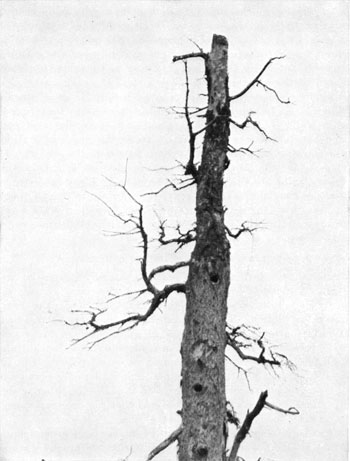 FIGURE 30. – If all dead trees are removed from the vicinities of roads and development centers, the birds that depend upon them for nesting, feeding, and perching will not beseen by the majority of visitors. Photograph of nesting tree of flickers and bluebirds taken July 19, 1930, at Poudre Lake, Rocky Mountain. Wild Life Survey No. 969 |
The floor of Yosemite Valley. – No other spot in a national park has as many wild-life problems of this type. Permanent residents alone number several hundred, and there are days when ten to twenty thousand people and thousands of cars are circulating in an area approximately 6 miles long by 1 mile wide between the great confining walls. They constrict the seasonal drift of game into a bottle neck. These walls tend to isolate the characteristic transition-zone fauna of the valley from any near-by source of replenishment. Further, the cliffs restrict the movements of visitors, with the result that by far the greater percentage of them never leave the valley itself. Wild life of the floor is the only wild life that they see in the park. Hence, it is of the utmost importance that this part of the park fauna be preserved intact.
Yet it is only because the natural conditions are so abundantly favorable that the wild life has resisted decimation as well as it has. Probably every plant and animal has been affected by human invasion. Some of the more conspicuous adverse influences are discussed here. No criticism of the splendid administration of the area is implied, the purpose being merely to demonstrate some of the adverse effects of human populations upon the faunal resources.
(a) Oil is spread on dead waters seasonally as a mosquito-abatement measure. This spells death to birds of many species that come to the quiet pools to bathe. One of the writers has picked up dozens of oil-soaked birds in the meadows, and within the space of a half hour once saw two blackbirds and a robin floating down the Merced River. Total losses from this source must be considerable.
(b) Clean-up work. Many standing snags have to be removed in the interest of human safety because they are located near roads and buildings. This has unfortunate consequences in the elimination of necessary nesting, concealment, and food habitats for many species of both birds and mammals, including flying squirrel, screech owl, spotted owl, saw-whet owl, pigmy owl, hairy woodpecker, willow woodpecker, white-headed woodpecker, pileated woodpecker, California woodpecker, red-shafted flicker, violet-green swallow, red-breasted nuthatch, and mountain chickadee. Fortunately, the policy of allowing dead trees to stand wherever possible has been in force in the valley for some time.
Dead brush and downed timber must be largely removed where there are so many people, and the visitors utilize all dead wood available around their camps for kindling. This means a habitat loss for a long list of mammals and birds.
(c) Trampling. Barriers are skillfully used to keep automobiles to the roads and parking areas. Paths are provided both for pedestrians and for horses. Nevertheless, the destruction of ground plants by millions of trampling steps is tremendously effective in destroying the food and protective cover of such vertebrates as deer, chipmunks, and ground and bush-nesting birds. Yosemite has set the example in adoption of measures to minimize the sheer physical destruction to wild life resulting from concentrated human populations.
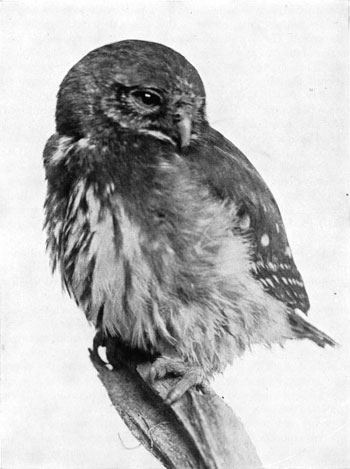 FIGURE 31. – The pigmy owl, bird demon of Yosemite Valley, nests in vacated woodpecker holes. Its continued presence depends on the availability of its particular housing needs. Photograph taken July 2, 1929, in Yosemite Valley. Wild Life Survey No. 7 |
(d) People accidentally reveal concealment places of nests and of young to lurking enemies. In Yosemite countless bird nests are discovered by humans who do not harm the eggs or young themselves but all unwittingly betray them to marauding blue-fronted jays and squirrels. This tends to increase the losses from these sources abnormally. Moreover, the jays are, if anything, more abundant than normal because man has brought them an increased food supply. In this particular instance the effect of development is to help the enemy and injure its prey.
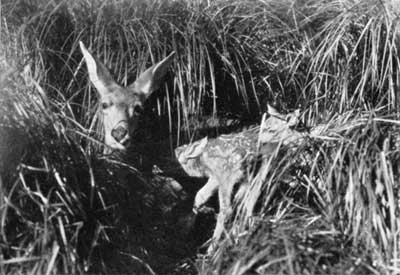 FIGURE 32. – People discover the fawns of mule deer secreted in the meadows and so unconsciously help to reveal their hiding places to lurking enemies. Photograph taken July 14, 1929, in Yosemite Valley. Wild Life Survey No. 2427 |
Fawns of mule deer are secreted in the tall clumps of saw grass and in other nooks about the valley during the first days of their lives. Their spotted coats make them inconspicuous, and the members of this family have an added protection in being scentless when they are very small. When visitors go to the hiding places or handle the young fawns, they leave a blazed trail for the predators to follow. Black bears and coyotes frequently kill fawns in the meadows and this may be one reason why they discover them more easily.
(e) Relation of travel season to food supply. During the summer season the food supply of some animals is greatly augmented and their numbers about development centers are increased thereby. In Yosemite Valley this is certainly the case with black bears and, very probably, with mule deer. When fall comes this artificial food is no longer available and the drain on the natural food becomes very heavy, with detrimental results to both forage and animals.
(f) Displacement of predators in its effect upon rodents and ungulates. Where man's presence influences one species adversely, the fact that it also keeps enemies of that species away is a compensating factor. But for species that thrive near civilization, the absence of the controlling predators increases the problem.
Mountain lions shun the valley. Even if their numbers were normal for the park as a whole, they would not linger where there are so many people. Both wild cats and coyotes frequent the valley, but do not hunt too near the camps and buildings. The same is generally true of the larger hawks. Consequently man has not only favored the California ground squirrels with an excellent food supply, but he has protected them against their natural enemies until they have multiplied greatly. This is one instance where safe control measures applied to those particular areas would be actually beneficial to wild-life values. Shooting the squirrels around buildings or camps is perfectly safe and sufficiently effective as a control measure.
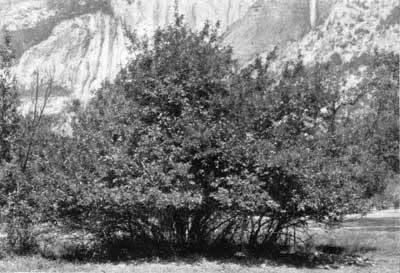 FIGURE 33. – The browse line on this chokecherry clump indicates how the mule deer are forced to utilized every bit of available forage during certain seasons of the year. Photograph taken July 20, 1929, in Yosemite Valley. Wild Life Survey No. 195 |
DISTURBANCES ON BREEDING GROUNDS (14)
Colony-nesting birds in general are intolerant of invasion of their breeding grounds. A constant trek of visitors may lead to abandonment of the colony. Inasmuch as some species do not easily find sites which are suitable for their particular nesting requirements they are likely to leave the park as well as the area from which they have been driven. The loss of any species in the faunal quota of the national parks is a tragedy.
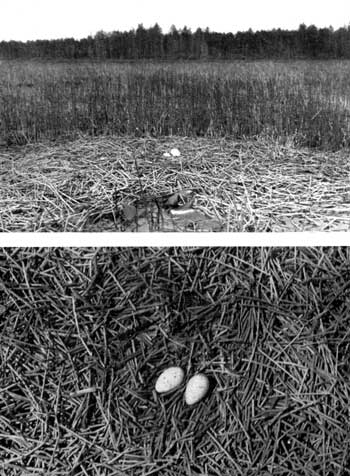 FIGURES 34a, 34b. – Such large ground-nesting birds as the sandhill crane can not persist where there is much use of their breeding grounds by people. Photographs taken June 8, 1931, in Bechler River district, Yellowstone, by G. M. Wright. Wild Life Survey Nos. 2310 and 2311 |
But even if the birds continue to frequent the colony, their numbers may be reduced from year to year through the destruction of eggs and young which accompanies the precipitate flight of the adults and prolonged absence from the nests. So the ultimate fate of the colony may be the same.
This situation can be readily met by making special administrative areas of the nesting grounds so that all entry may be barred during the critical season. The best interest of the birds can be safeguarded in this manner without appreciably restricting the use of the park as a whole. Moreover, under favorable circumstances, arrangements may be made for the observation of the activities going on in the colony from some vantage point near by.
Even solitary nesting species would be benefited by this type of protection in some instances. Any large ground-nesting bird that is rare should be investigated from this standpoint. If the Bechler River district of Yellowstone were ever developed (a move which the swarms of mosquitoes should effectively block), one of the last strongholds of the sandhill crane would be endangered. This bird can not nest successfully where there are many people. The following incident is illustrative. A member of the field party flushed a brooding sandhill crane. In its hurried departure the bird knocked an egg out of the nest. With a bird that lays two eggs to a clutch, such a loss is a serious matter and the crane is so rare that every individual is precious.
The problem of special protection on breeding grounds is a minor one in most parks, though, in the case of the proposed Everglades, the major objective of development would be to establish a mutually advantageous relationship between the visiting public and the great bird rookeries.
White pelican in Yellowstone. – Grotesque on land and superb in flight, the strange white pelican is one of the most interesting members of our avian fauna. It is estimated that the agency of man has reduced its numbers in the United States by half in the last quarter century. The only white pelican breeding colony now found within the confines of a national park is at Molly Island, in Yellowstone Lake. This is a small colony of between one and two hundred breeding pairs.
Human trespass on pelican islands during the breeding time is injurious to the birds in several ways, as E. Raymond Hall18 has shown in his studies of the great colony at Pyramid Lake, Nev. Eggs are broken and the downy young are wounded or killed by strokes of feet and wings when the old birds are suddenly frightened into flight. A little later on the young pelicans mass together in pods. These pods stampede at the approach of an enemy, with the result that many individuals are trampled and left behind dead or dying. If the parents are driven off during the middle of the day, the pelican babies and eggs are killed by the heat of the sun; if at night, they will perish from cold, depending, of course, upon the length of exposure. Moreover, the white pelican is one of the birds that readily abandons a nesting island if it is disturbed. There are instances where this has happened and the birds have never returned.
The protection of the Molly Island colony is simplified because the island is sequestered in a southern arm of the lake. However, future developments could change all this, and even now precautions are necessary to prevent too many visits to the island.
Sanctuary status for species which have their rookeries on mainland requires more administrative effort, such as is involved in posting signs, erecting barriers across roads, and running special patrols.
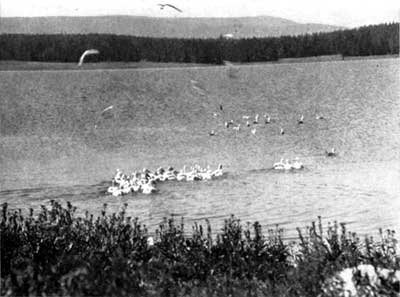 FIGURE 35. – This pod of white pelicans, representing the entire 1931 crop of the Molly Island colony, fled at our approach. When a pod is disturbed in this way while the birds are younger, some of its number may be trampled to death. Photograph taken July 18, 1931, at Molly Island, Yellowstone, by G. M. Wright. Wild Life Survey No. 2317 |
18 Pelicans versus Fishes in Pyramid Lake, by Hall, E. Raymond, the Condor, vol.XXVII, pp. 147-160, July, 1925.
PASTURING OF SADDLE HORSES (15)
One of the accompaniments of man in the park has been the occupation of the range by horses, which are kept both as an administrative necessity and for recreational use. Nevertheless, there is a certain inconsistency in use of the park range by this stock.
Man does not maintain himself in the park at the expense of that park's resources. With this single exception, everything that is needed for human use is brought in from the outside. There is no more reason why the native range of the game should be used to support the horses which man rides than that it should be utilized to feed cattle to provide meat and drink, or plowed up to raise vegetables. The practice of importing finished foods so that nothing will be taken from the park is so much a matter of custom that the costliness is borne without question. Should not the same principle apply to the sustaining of livestock?
Horses impose a heavy drain upon the resources of the range. Scarcity of winter range is one of the most important wild life problems in nearly all of the parks. The forage utilized by the stock must be paid for later on by artificial winter feeding of game.
EFFECTS FROM THE MANNER OF WILD-LIFE PRESENTATION (16)
The art of appreciation of wilderness life in national parks is still in the beginning stages of development. It is the first sort of contact that most people have ever had with large animals roaming at liberty. In the novelty of the experience it is natural to exercise the same standards of enjoyment which apply to the appreciation of the so-called wild animals of zoological gardens. There the most exciting factor was the proximity to the wild caged animal. In the parks the visitor realized the highest joy in the new contact when his picture was taken stroking the back of a deer. If the object of affection could be that more formidable animal, the bear – well, so much the bigger impression on the home folks.
The new emphasis is on perfecting the manner of presentation of the visitors to the wild life rather than on how the animals can be drawn out of their natural wilderness existences to be presented to the visitors. Through the educational branch of the Service, thousands of people are being led for the first time to an appreciation of the greater fascination of wild life in nature as compared to the paler pleasure of feeding semidomesticated animals by hand. They are beginning to seek the story of the endless change and struggle and the marvelous interrelations of all living things in the wilderness.
This new idea is a more sophisticated concept than the old one and hence it does not represent the state of mind of the majority as yet. But all of the progress made in the park system, including its very conception, has been based on an idealism which did not wait for the average standards. If national-park developments had been based on the absolute level of average ideas, they would not be any thing more than amusement parks to-day.
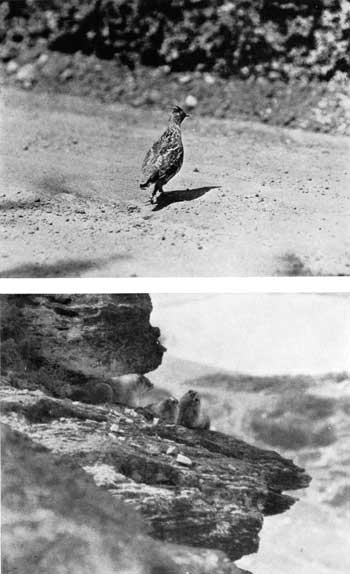 FIGURES 36a, 36b. – The ruffed grouse crossing the road represents but half the picture. The hoary marmot family on its home ledge is complete in its natural setting. Photograph of ruffed grouse taken June 25, 1930, at Blacktail Deer Creek, Yellowstone. Wild Life Survey No. 701. Photograph of hoary marmot taken September 1, 1931, at Cracker Lake, Glacier, by G. M. Wright. Wild Life Survey No. 2181 |
All of this may seem far removed from the question of animal problems, yet there is a close connection. If the animal life is to be coerced into an abnormal life for presentation to the visitor, the situation is fraught with possibilities of disastrous effects both upon the species concerned and the biota of the park as a unit. If the wild life is left in place and man introduced to the whole natural picture instead of being shown tamed animals, there will be much less disturbance of the natural balance and hence fewer problems.
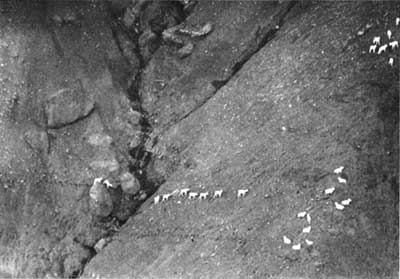 FIGURE 37. – Dall sheep are at home on the shaly cliffs. The joy of seeing the animals in their natural setting can not be equalled by any other manner of presentation. Photograph taken July 22, 1926, at Double Mountain, Mount McKinley. Courtesy of the Museum of Vertebrate Zoology, University of California, Berkeley, Calif. Mus. Vert. Zool. No. 5200 |
Bears in Yellowstone. – In an earlier discussion the dangers to man in the conflict between visitors and bears were analyzed. There is another side to the question in the harm which may come to the bears from the new contact. This can only be postulated, for there has not been time enough as yet for changes to become manifest and no research has been undertaken to make definite determinations.
The manner of presentation of bears in this and other parks has been to feed large quantities of garbage in arenas, there being one or more of these according to the distribution of human-population centers. This has brought about unprecedented concentration of bears in small areas in Yellowstone. What are some of the adverse or possible adverse effects upon the bears resulting from this manner of presentation?
(a) The intimate association of many bears at one time on the feeding grounds must facilitate the spread of diseases or parasites which may be endemic in bears in Yellowstone, or of any diseases which may be introduced among them.
(b) The garbage itself, including the remains of domesticated animals, may introduce parasites.
(c) The rich concentrates in the garbage are an unnatural food for bears; and if feeding of them is continued for many bear generations, injurious physiological changes in the make-up of the bears are exceedingly likely to occur.
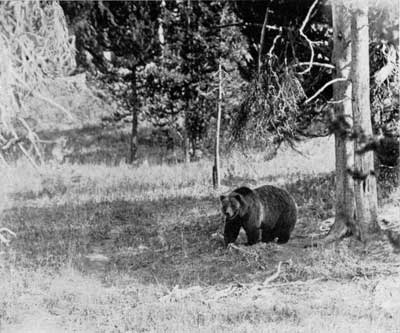 FIGURE 38. – There is no lordlier sight among the animals of the United States than the grizzly bear when its is found in completely natural surroundings. Photograph taken September 13, 1929, at Canyon Lodge, Yellowstone. Wild Life Survey No. 507 |
(d) The garbage season is coincident with the tourist season and not with the bear requirements. As a result of this uneven distribution of food, there is likely to be a scarcity of feed at the critical times. If it is true that because of this unnatural condition the females go into hibernation in a poor condition, there is a genuine possibility that the cubs born in the winter months will suffer until eventually degeneration of the race will take place as a result.
(e) Inasmuch as the garbage is concentrated in areas a few yards square, the old bears are able to dominate tIme situation at the expense of the younger animals. It is possible, on the other hand, that the young animals learn only the feeding habits of their elders; and not being trained to rustle their natural foods, become the small scrawny hold-up bears so common on the Yellowstone roads.
(f) The garbage pits must cause a desertion of the niche formerly occupied by the bears in the summer time, thus further disturbing normal biotic relationships in the park.
(g) Garbage feeding attracts the bears to the vicinities of the food stores of campers and encourages a lack of fear of man. The cubs know no such fear right from the start. In the new contact the bears offend man, who has the whip hand, so that the bears are bound to be the sufferers in the end.
(h) Bears appear at their worst on the garbage platform, so that their characters, in the minds of the visitors, suffer as well as does very probably their physical well-being from this manner of presentation.
To conclude, it might be said that this manner of presentation of bears is very likely to be to the ultimate detriment of the bears. Certainly it is responsible for much of the injury to man. The bear show has been one of the greatest assets of the national parks. However, it has served its greatest purpose in the period when bringing the people to an appreciation of the wonderful things to be seen and done in the parks was of prime importance. Now that the popularity of their values is established and their place secure, it may be necessary to modify the old practices in the interests of the welfare of both people and bears.
The whole question is one which deserves thorough study, for there is no doubt but that the bear problem is increasing in magnitude in Yellowstone and other parks. It may be feasible to reduce the amount of feeding and to improve the selection of food. Perhaps a natural bear food, such as honey, could be used to attract bears to certain places so that the visitor limited to a very short stay in the park could be assured of at least one good view of a bear. The sight of one bear under natural conditions is more stimulating than close association with dozens of bears. Even now one hears more accounts of encounters with an individual bear than of the bear show.
| <<< Previous | <<< Contents>>> | Next >>> |
fauna/1/chap3.htm
Last Updated: 01-Feb-2016